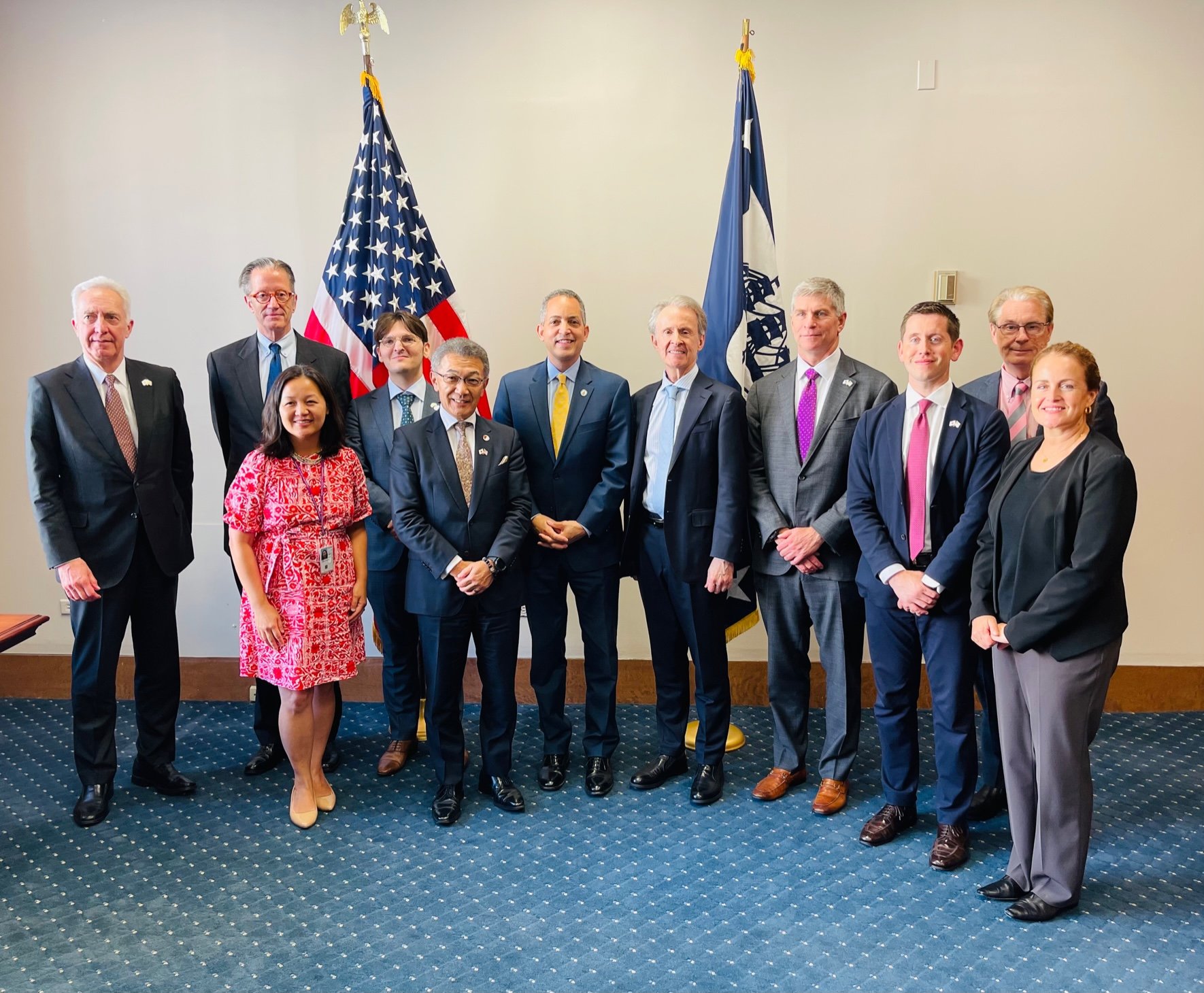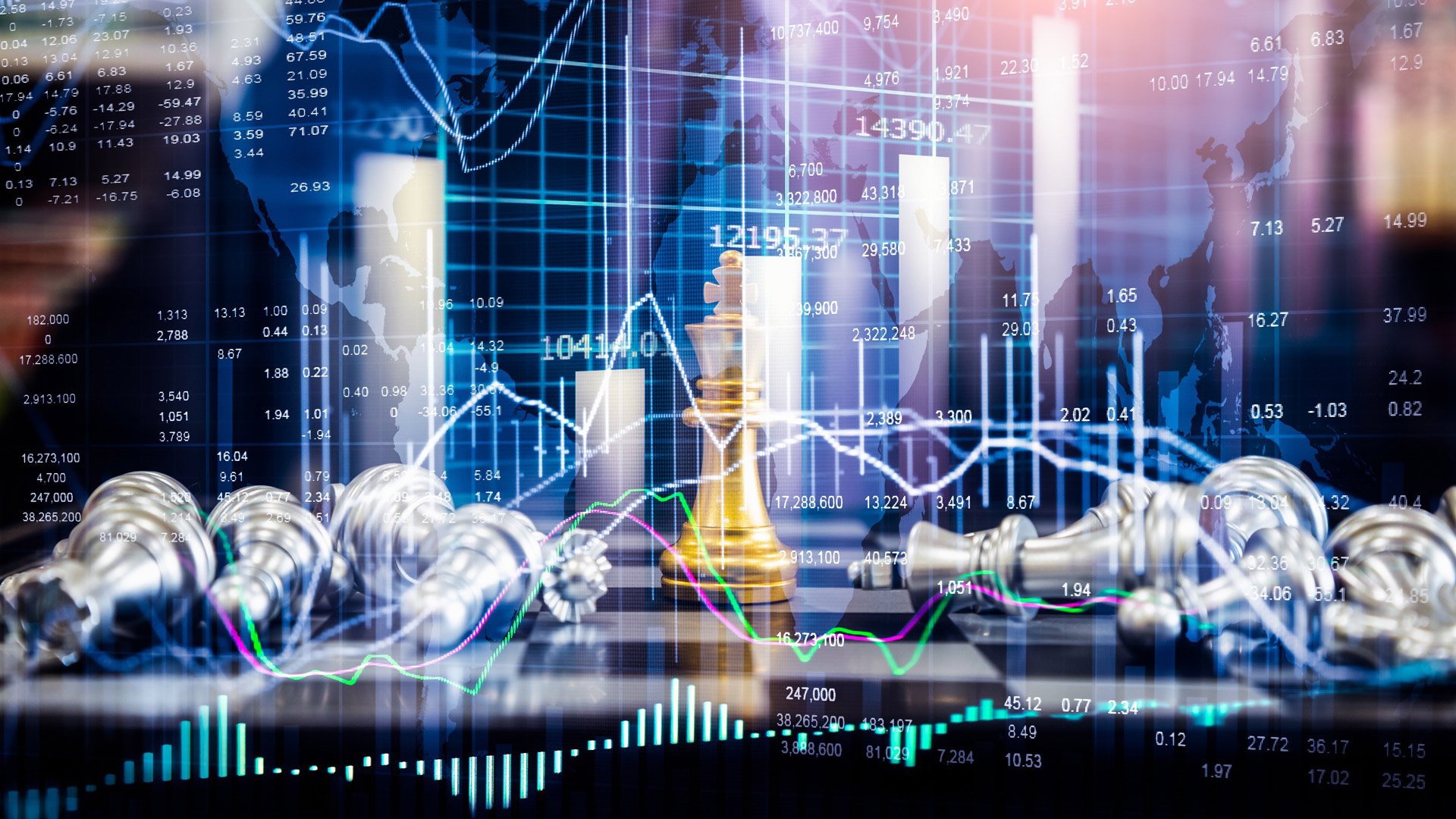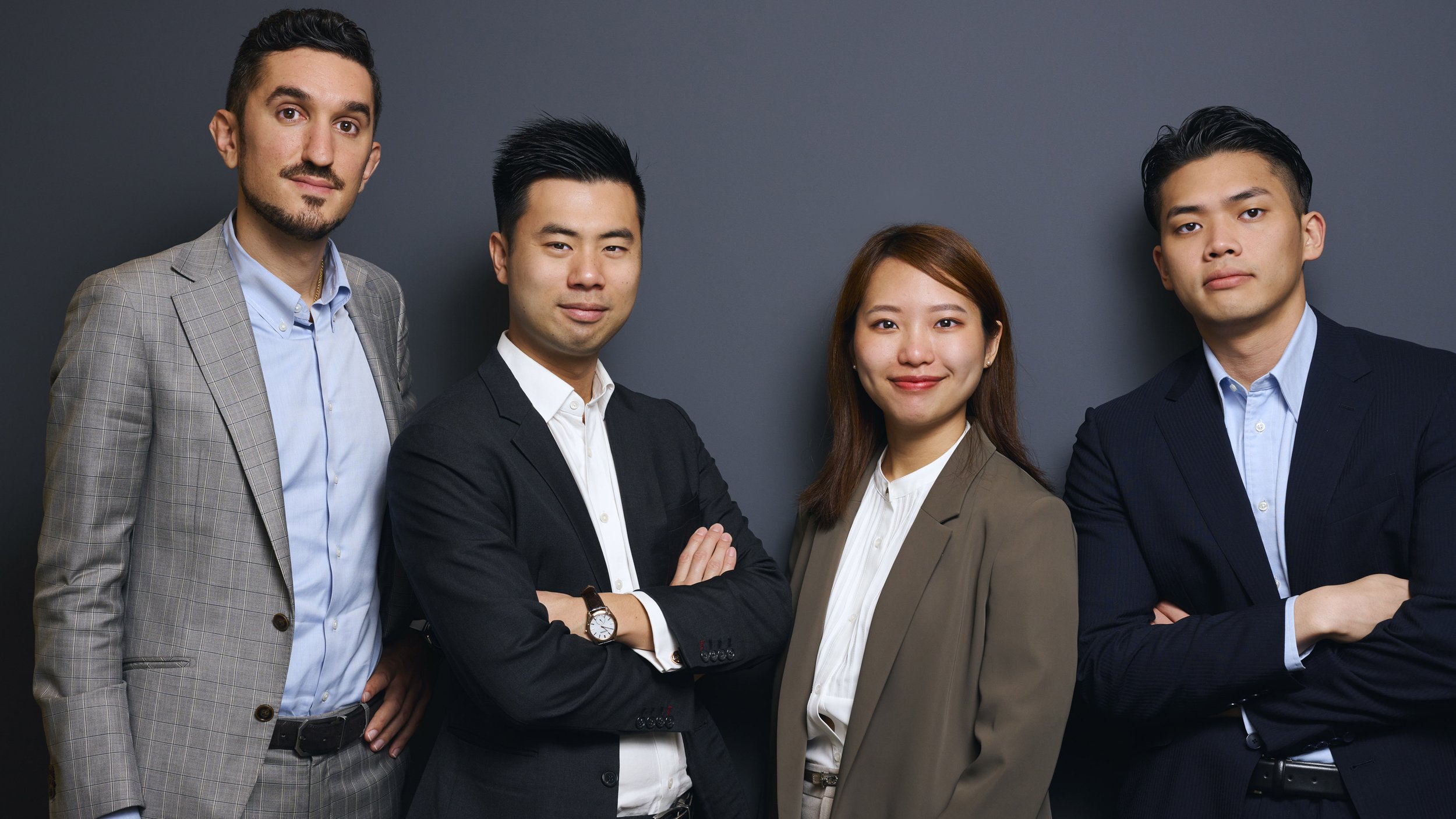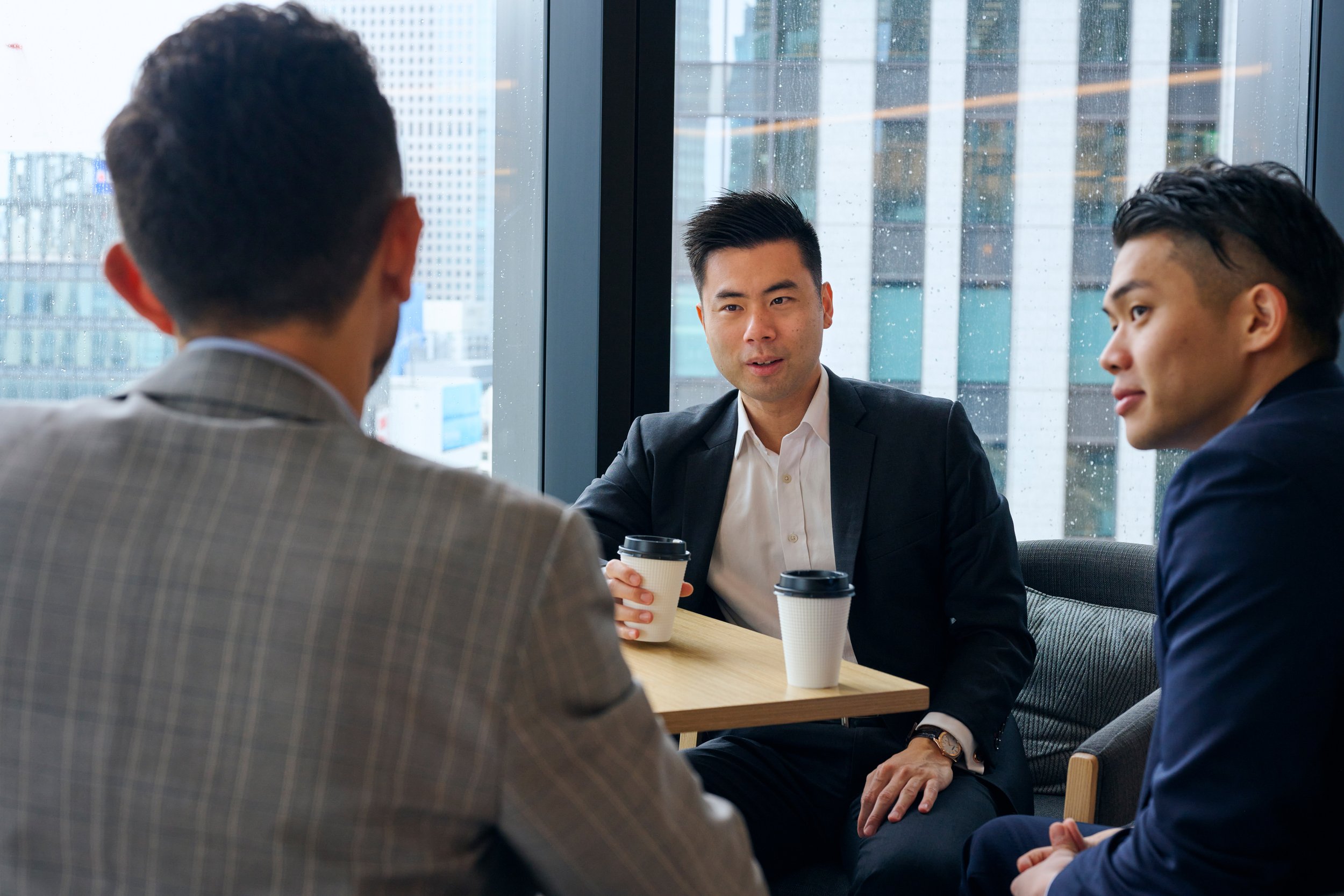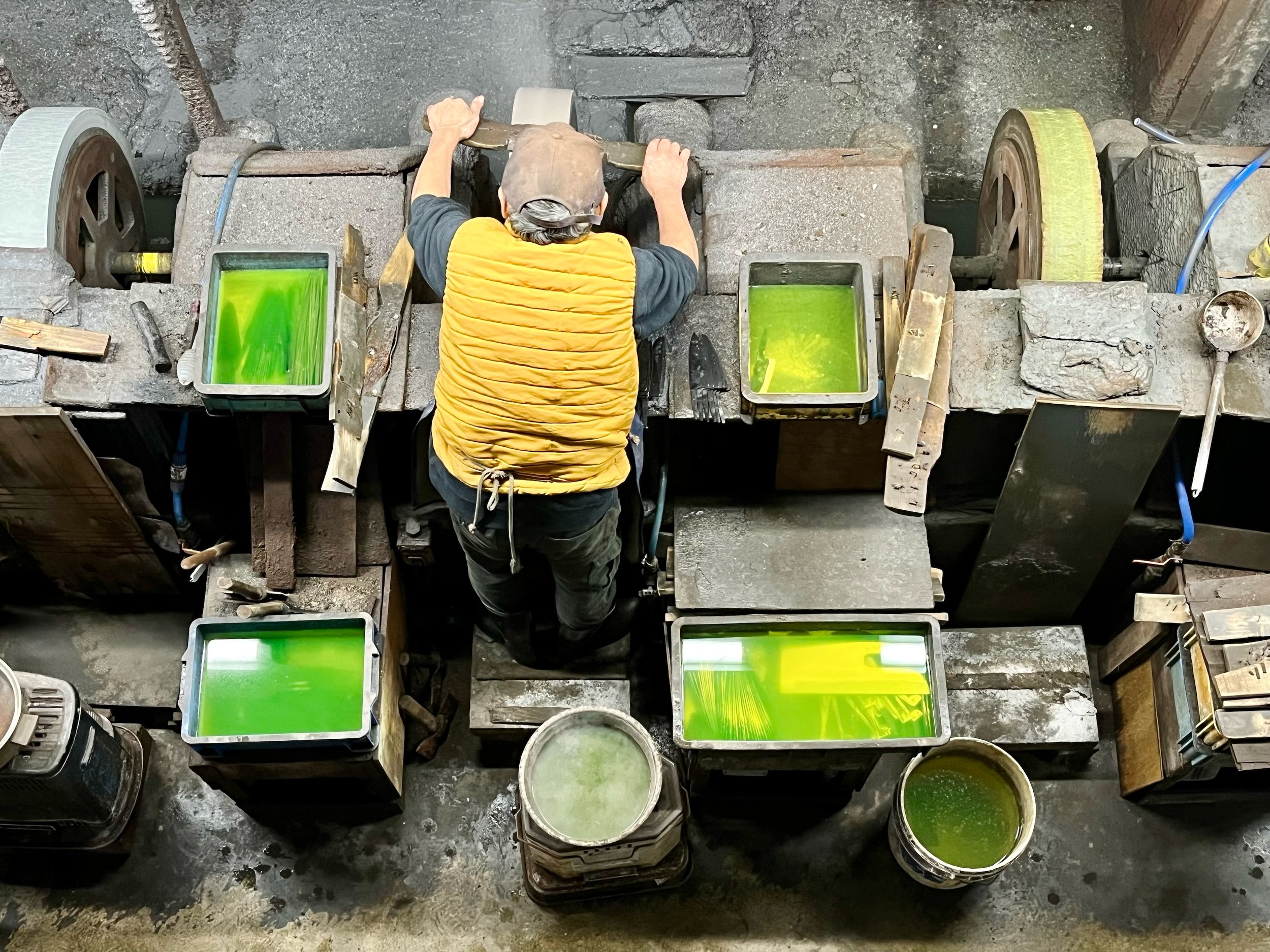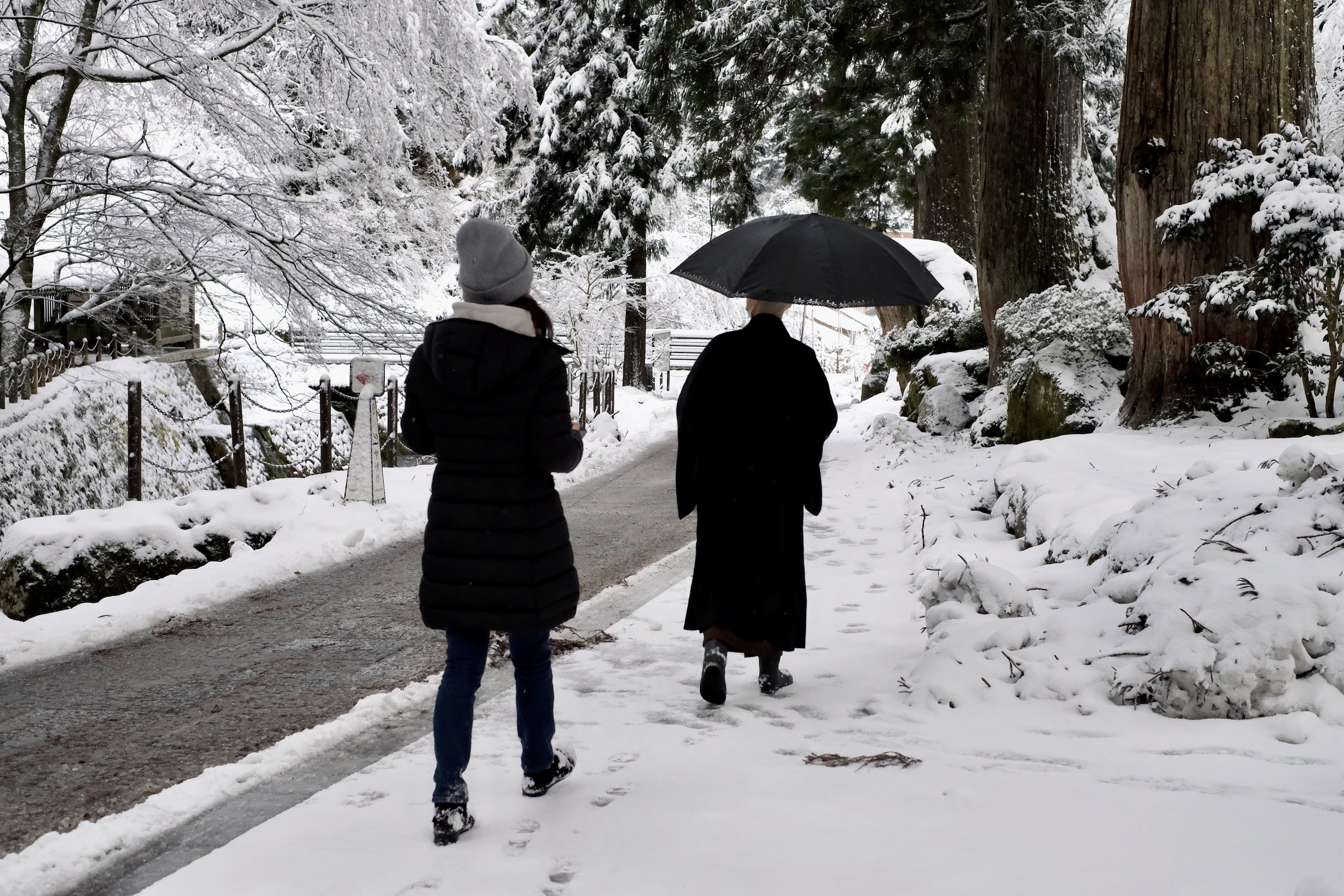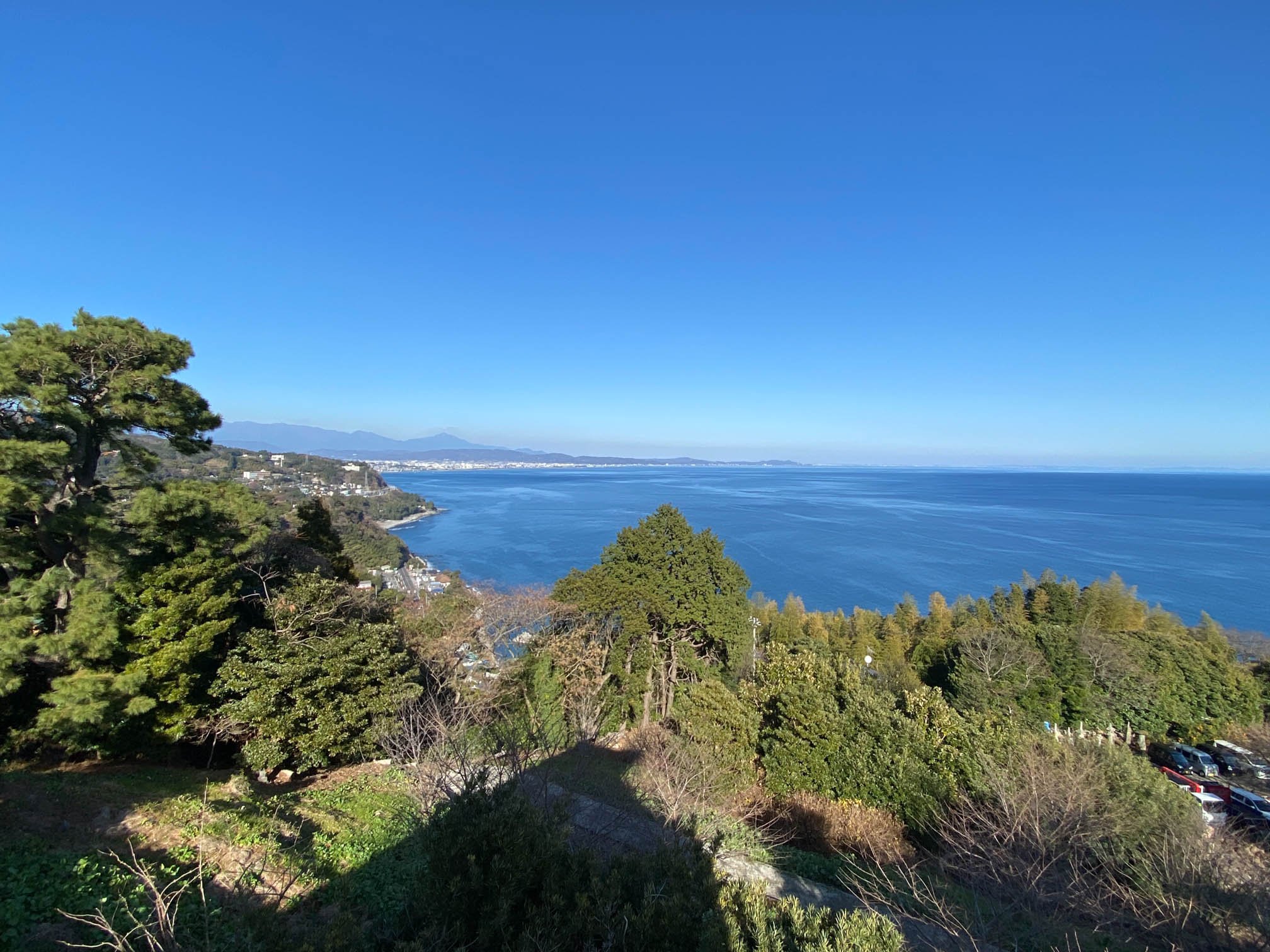2023 DC Doorknock
During the first full DC Doorknock since 2019, ACCJ delegates met with leaders in Washington, DC, to discuss security, economic, and strategic partnerships.
The 2023 ACCJ DC Doorknock delegates gather in front of the US Capitol.
On September 12 and 13, American Chamber of Commerce in Japan (ACCJ) leaders made their first full visit to Washington, DC, since the start of the coronavirus pandemic. These DC Doorknock visits are an important part of the ACCJ’s advocacy efforts and strengthen US–Japan relations.
ACCJ President Om Prakash was joined by Vice Presidents Jason Hyland and Victor Osumi; Governors Hans Klemm, Frank Packard, and Will Shaffer; Treasurer Steven Briggs; Special Adviser Christopher LaFleur; Digital Forum Vice-Chair Kristopher Tate; and Executive Director Laura Younger.
The delegation was warmly welcomed by administration officials, members of Congress, and officials from the Embassy of Japan and the US Chamber of Commerce. Topics of discussion included security, economic, and strategic partnerships.
Strengthening Cyber Risk Management
ACCJ member Ted Sato shares how his new cybersecurity book, written in collaboration with Keidanren, came about and discusses the issues it addresses.
Keidanren collaboration delivers book with practical advice to corporate leaders
As concern about cyber risk grows in Japan, a new book by veteran American Chamber of Commerce in Japan member and Marsh Japan, Inc. Senior Vice President Ted Sato aims to help corporate management find the most effective approach to mitigating risk and effectively responding to events.
Sato authored the book with Toshinori Kajiura, a member of Keidanren (the Japan Business Federation) and a senior researcher for information and communications technology policy at Hitachi. Kajiura was previously chair of Keidanren’s Working Group on Cybersecurity Enhancement.
🔼 Watch the video above for more insights from Sato himself.
Published in February by the Nikkan Kogyo Shimbun, a Japanese industry newspaper, Strengthening Cyber Risk Management: A Keidanren Handbook to Cyber Risk Management is designed to provide corporate managers with practical guidance for dealing with cyber risk.
Not to be confused with cybersecurity, cyber risk is defined by the US Department of Commerce’s National Institute of Standards and Technology as the “risk of financial loss, operational disruption, or damage from the failure of the digital technologies employed for informational and/or operational functions introduced to a manufacturing system via electronic means from the unauthorized access, use, disclosure, disruption, modification, or destruction of the manufacturing system.”
Sato told The ACCJ Journal that the book, which spans more than 200 pages, was written by professionals from the battlefield in easy-to-understand language. “We wanted corporate managers to be able to ask effective questions at the earliest stages of any cyber risk event. That is very important.”
“We wanted corporate managers to be able to ask effective questions at the earliest stages of any cyber risk event. That is very important.”
The idea came after a series of events last May which Sato conceived with Nikkan Kogyo Shimbun. The well-received sessions showed corporate managers how to deal with cyber risk, not solely as a technical issue but to emphasize management and factors related to organizational culture.
Keidanren had been hosting its own events since 2014, working to change the mind-set of corporate management on this critical issue. The organization built on Sato’s efforts to bring together professionals with similar motivation to create the Cyber Risk Management Japan Study Group, which was a supporting contributor to the book.
These efforts were also supported by the late Hiroaki Nakanishi, who was chair of Hitachi and Keidanren and contributed the foreword.
The book’s core advice draws on a 2014 report by the Internet Security Alliance and the National Association of Corporate Directors’ handbook on cyber risk, which recommends a one-team approach to corporate management. Beginning with the importance of expert advice from outside the company, the book advises an “art of science” approach that balances technology, human factor management, and operational excellence to ensure an organization’s readiness, response and recovery, and recurrence prevention.
The book has been well received by reviewers for its practical guidance.
“It is very meaningful to promote cooperation with experienced US firms at this early stage for Japanese companies,” Sato said. “If all goes well, next we plan to make an English version to share in Asia.”
The Bishop Family Memorial Scholarship Fund
On June 12, the ACCJ and the United States–Japan Bridging Foundation gathered at Tokyo American Club to honor the family and launch the Bishop Family Memorial Scholarship Fund at an event entitled Lives Lived for Bridging the United States and Japan.
Honoring the legacy of ACCJ leader Bill Bishop and his family through education
As a typhoon slammed Yokota Air Base in July 1974, a plane rocked its way down to the runway. Onboard was navy photographer Bill Bishop. That first night, he also experienced his first earthquake. It was a dramatic start to a five-decade relationship with Japan that would lead the South Dakota native to become a key part of the US business community in the country.
Last December, on Christmas morning, Bishop, his wife Izumi, and their daughter Sophianna lost their lives, killed by their neighbor at their family home in Saitama Prefecture.
Members of the American Chamber of Commerce in Japan (ACCJ) remember Bishop for his kindness, humor, friendship, and dedication to the chamber, where he served as chair, vice-chair, and board liaison of the Healthcare Committee over the years.
On June 12, the ACCJ and the United States–Japan Bridging Foundation gathered at Tokyo American Club to honor the family and launch the Bishop Family Memorial Scholarship Fund at an event entitled Lives Lived for Bridging the United States and Japan.
In attendance were US Ambassador to Japan Rahm Emanuel, representatives of Tochigi Prefecture Governor Tomikazu Fukuda, and ACCJ members and guests.
“We hope creating a fund that will support students who will come from the US to study in Japan, at Temple University, will be an incredible way to support Bill and his family’s legacy.”
Tom Mason, the foundation’s executive director, said, “We hope creating a fund that will support students who will come from the US to study in Japan, at Temple University, will be an incredible way to support Bill and his family’s legacy.”
Bishop studied in Japan himself and received a bachelor of arts degree from Sophia University. He earned a master’s degree from Temple University in Philadelphia, and later became a lecturer and board member at the Japan campus.
The event also marked the 25th anniversary of the United States–Japan Bridging Foundation, which provides US undergraduates—especially those from historically underrepresented communities—with scholarships to study abroad in Japan. It also offers mentorship and networking opportunities to build a Japan-related career, fostering the next generation of US leaders with connections to the bilateral relationship. Since its founding in 1998, the group has supported more than 2,000 students.
Some of this year’s Bridging Scholars, as well as alumni, also joined the event to share their experiences studying in Japan thanks to the foundation’s support.
The Bishop Family Memorial Scholarship Fund will be based at, and managed by, the US–Japan Bridging Foundation, which will administer and manage the scholarship and its programs—including the recruitment of students. Logistics, fundraising, and community support will be provided by the ACCJ.
Education Committee Vice-Chair Thierry Porte, who is also chairman of the United States–Japan Bridging Foundation, is happy to be a part of this.
“I knew Bill Bishop well,” he told The ACCJ Journal. “He and I worked together in the late 1990s to early 2000s at the ACCJ, and he was an active member of the American community in Japan. As [he was] someone who was very active working with students, there was quite a bit of movement in the community to remember Bill and his family.”
Porte said the Bishop Family Memorial Scholarship Fund will be a “living memorial to Bill, his wife, and his daughter and the logical place to collaborate would be the ACCJ, where Bill was very active and his daughter interned.”
Happy Independence Day 2023!
On the 247th anniversary of the birth of our great nation, I would like to extend my warmest wishes for a Happy Fourth of July to our friends and partners at the ACCJ.
A special message for ACCJ members from US Ambassador to Japan Rahm Emanuel
On the 247th anniversary of the birth of our great nation, I would like to extend my warmest wishes for a Happy Fourth of July to our friends and partners at the American Chamber of Commerce in Japan (ACCJ). Going on my second year in Japan, I am humbled by what we were able to accomplish. The ACCJ’s leadership played no small role in helping accomplish our mutual goals. While looking at our impressive accomplishments, it is important to note that there is much left to do.
Over the past few years, the US–Japan Alliance has become a cornerstone of peace and stability in the Indo–Pacific. As discussed at the G7 Summit in May, the importance of defending democratic values in eastern Asia cannot be overstated. Japan’s dedication to this cause can be seen by its reinforcements of defensive and diplomatic capabilities. Our bilateral cooperation has only deepened behind the promise to protect the rule of law and sovereignty.
Russia’s war in Ukraine is a direct attack on international order and the biggest modern threat to sovereignty globally. The invasion threatens to undermine the principles of sovereignty and territorial integrity. In response to the unjust war, the United States and Japan held steadfast in our dedication to global security and led international pushback against the Kremlin. Japan and the United States led sanctions, export controls, freezing of Russian assets, and donations to the Ukrainian cause.
This challenge strengthened international cooperation to create a united front against the aggressions of Russia. This war and our united response to it has much wider ramifications than just in Ukraine. As the People’s Republic of China (PRC) continues to test the boundaries of the South China Sea and Taiwan, it is evident that the outcome of Russia’s invasion holds great weight in determining the PRC’s aggressiveness in the Indo–Pacific region. In response to the PRC’s encroachment in the South China Sea, the United States and Japan have advocated for a rules-based order in the region, condemning their behavior. To this end, we have worked with other countries in the region to promote freedom of navigation and overflight to address the PRC’s aggressiveness.
“Over the past few years, the US–Japan Alliance has become a cornerstone of peace and stability in the Indo–Pacific.”
As we address international concerns, we must not forget the urgency of combatting climate change. The United States and Japan are global leaders in the fight against climate change and in recent years our cooperation has only grown stronger. The US–Japan Climate Partnership is an example of this cooperation, which commits us to achieve net-zero emissions by 2050. We are making significant progress on this goal by increasing renewable energy and through researching and developing new clean technologies. Our cooperation is essential to addressing the climate crisis and acting as leaders in an international response.
All of this must be accomplished without neglecting the economies of both countries. The advancement of US–Japan economic relations in the past two years is a positive development for both countries and the global economy. Concurrently, we have launched several initiatives to support economic investment in Southeast Asia and to promote free trade in the region. We are committed to working together to address common economic challenges and we are well-positioned to continue to advance our economic relationship in the years to come.
We are fortunate to have strong allies in the ACCJ with common goals. We must never forget that our unity is our greatest strength. It is what gives us the power to defeat tyranny and build a better world. What we can accomplish with the US–Japan alliance in the next two years will shape the future of the Indo–Pacific region for decades to come.
Happy Independence Day. I am confident in our work together. Let’s get it done.
Disclaimer: Opinions or advice expressed in the The ACCJ Journal are not necessarily those of the ACCJ.
Juneteenth: Seeds of Hope (Audio)
The ACCJ Journal sat down with CIC founder Tim Rowe in the bustling Toranomon Hills networking hub to learn more about how he went from sharing a space with friends to leading a community for entrepreneurs that includes more than 1,000 companies at centers in eight cities around the world.
Legacy Foundation Japan's LaTonya Whitaker shares inspiration and plans to celebrate this important American holiday and build bridges between the US and Japan.
Ahead of the Juneteenth holiday, we sit down with LaTonya Whitaker, executive director of The Legacy Foundation Japan, to talk about plans for the foundation’s Seeds of Hope gala at Tokyo American Club.
As an entrepreneur, the Mississippi native is well known to many in our community for Soul Food House, the comfortable and delicious oasis of authentic Southern food in Azabu-juban. But her work extends far beyond those flavors. In this interview, LaTonya shares her experiences learning about the history of June 19, the inspiration for the gala (now in its second year), and how the business community can get involved.
Learn more about the Seeds of Hope Gala
Learn more about The Legacy Foundation Japan
Innovation Engine
The ACCJ Journal sat down with CIC founder Tim Rowe in the bustling Toranomon Hills networking hub to learn more about how he went from sharing a space with friends to leading a community for entrepreneurs that includes more than 1,000 companies at centers in eight cities around the world.
CIC co-founder Tim Rowe shares his entrepreneurial journey and vision for collaboration in Japan.
Like so many new graduates, Tim Rowe and his friends from the Massachusetts Institute of Technology (MIT) left their Cambridge campus with diploma in hand and took “ordinary” jobs. A few years later, in 1999, they quit those jobs to build
start-ups.
But they needed offices—not the easiest thing for young entrepreneurs to pay for in a town that’s home to two of the world’s most prestigious universities. So they decided to share a space near MIT and Harvard to lighten the financial load. At least one of their companies would make it, they thought.
The shared space led them down an unexpected path, however, as more companies moved in and they went from five to 10 to 50 to 100. The Cambridge Innovation Center (CIC) was born.
Fast forward two decades and CIC opened its first Asia facility in Tokyo, in the Toranomon Hills Business Tower. The ACCJ Journal sat down with Rowe in the bustling networking hub to learn more about how he went from sharing a space with friends to leading a community for entrepreneurs that includes more than 1,000 companies at centers in eight cities around the world.
How did CIC expand?
For the first 13 years or so, we just grew right there in Cambridge. I had little kids at the time and didn’t really want to travel as much. And Cambridge is an amazing place for start-ups. So, we just kept taking more space and filling it. It was really kind of a surprise to us. We didn’t set out to build a shared space for start-ups as a business. We were actually just
using it for ourselves.
My mother had been the ombudsman at MIT, and one of her friends who had been the provost of MIT, Mark Wrighton, had become the chancellor of Washington University in St. Louis, one of the top medical schools in the United States. She said, “Mark called and wants you to come to St. Louis.” I was about to give all the reasons why I didn’t know if I could do that, but then she was like, you gotta go. Okay, Mom. So, I flew to St. Louis and met with Mark Wrighton. He said, “Look, we want you here, and we’re going to help you figure it out.”
One thing led to another and we opened in St. Louis. A few years later, the federal government was looking for a home for the National Geospatial-Intelligence Agency, and they toured St. Louis. They came to our center and said this is the kind of vibe they were looking for. They actually testified before Congress that they selected St. Louis because of their experience at our center. It was a $2 billion investment, a big deal for the local economy. After that, as other people came and knocked on the door, we said, “Sure, let’s look into it.”
How has the view of start-ups changed?
If you survey new college graduates, they often say the number one thing they want to do is go create a start-up. I think it’s good for the world, because what we’ve learned is that innovation has the power to make the world better in so many ways. But what we’re finding is that innovation gets into the world, is adopted and spreads much more quickly, through new enterprises rather than existing ones.
When we’re part of a larger organization, we want to respect all the rules that exist in that organization. Doing new things becomes rather hard. We hear things such as, “We tried that once and it didn’t work,” or “That sounds interesting, but that’s 1/1,000 of the revenue of this company, so we can’t prioritize it.” That’s normal, and it’s been well studied. But the bottom line is that existing enterprises find it very difficult to introduce true innovation.
“They understand that it’s not about them so, when there’s something really new and interesting that they have in their company, they push it out. It’s like asking your teenager to move out of your house. It’s time now, it’s time to go off.”
I think the smarter of the big organizations understand this. They understand that it’s not about them, so, when there’s something really new and interesting that they have in their company, they push it out. It’s like asking your teenager to move out of your house. It’s time now, it’s time to go off. They do the same thing and take those teams and move them out of headquarters.
Why did CIC choose Japan?
There’s a personal reason and there are professional reasons. The personal reason is that, in my youth, my dad said that if I studied Japanese for a while he would help me get an internship here. And my grandmother spent about 10 years in Asia in her youth, in the 1920s—mostly in China but some in Japan—and she taught me kanji when I was a kid. That all got me interested in Japan, and I was fortunate to do an internship here during high school.
Professionally, if you look at the most successful companies in the world—and you can use any measure, but one would be the Russell 2000 Index—all those companies were at one point start-ups. So, another way to look at that list is that it is a list of the 2,000 most successful start-ups ever. When you break them down by country, you find that the United States and Japan tie for the number of companies on the list adjusted by population. So, historically, Japan ties for number one as a place to build start-ups. That’s a reason to be here.
Photos: ©CIC Tokyo
Is the Japanese government doing enough to support start-ups?
Building a start-up ecosystem is a decade-long process. A piece can come from a supportive government, and it’s really terrific that the Japanese government is leaning in. Other governments that have leaned in, such as Israel, have done really well. It’s clear that a national policy that pushes in this direction can pay big dividends.
But it’s not the only thing that needs to happen. You also need the entrepreneurs themselves. And I think the Japanese innovation ecosystem is responding. These days, if you talk to young Japanese people—and this is a change, perhaps just like what started to happen a decade ago in the United States—you see many more who say they want to build a start-up.
I see Japanese universities leaning into this, which is important. They’re doing entrepreneur programs like those US universities started a decade or more ago. I see a growing awareness of, and interest in, what we call innovation infrastructure. This is things such as shared wet laboratories, the physical infra-structure that allows for new start-ups in, let’s say, the biotech field.
We’ve built shared workspaces focused on a number of industries. The largest so far is the wet lab for life sciences. We collaborated with others to found a nonprofit doing that in Cambridge. It’s called LabCentral and is, as far as we are aware, the largest shared wet lab on the planet. It’s over 20,000 square meters and has every possible piece of equipment you would need in life sciences. Then we figured out how to make that commercially viable and built a similar facility, a commercial one, called CIC Labs in Philadelphia. It’s the largest commercial shared wetland facility in the world, to our knowledge.
How can Japan and the United States work together?
The good news is that the interests are very aligned for Japan, for the United States, for Japanese companies, and for US companies in Japan. Everyone in this circle benefits when they figure out how to get these collaborations to work well, and set a different way.
If you aren’t out there working with new technologies, which are often coming from start-ups, then you’re at risk that you’ll be Airbnb’d or Uber’d. You’re in the hotel business and someone figures out another way to have lodging. You’re in the taxi business and someone figures out another way to get people around the city.
“If you aren’t out there working with new technologies, which are often coming from start-ups, then you’re at risk that you’ll be Airbnb’d or Uber’d.”
This is core to the ACCJ itself. Really, what you’re talking about is brokering conversations. You’re getting people to know each other and to talk about what they’re doing, and how they might help each other.
When I was a young person at the Mitsubishi Research Institute in the early 1990s, I was a member of the ACCJ, because I saw—and I convinced my bosses—that the connections that could be made were meaningful and important. I think it’s no less relevant today. And I think that, as many of these companies have evolved, one of the things they’ve come to realize is that, while the connections between larger organizations are important, the connections between larger organizations and smaller fledgling ones are also important. The challenge is figuring out how to find those little companies and how to know which ones to work with.
What’s next for CIC in Japan?
We were approached by Nishitetsu, the major private railway company in Kyushu. They said, we like what we see at CIC Tokyo and we’d like to work with you to build another one in Fukuoka. We have announced that we’re in a formal collaboration and will soon finish all the due diligence to make sure this will really work. Then we can announce if, in fact, we’re moving ahead with construction, but it’s looking very good and we’re excited to be headed to the second site.
We’re also in several conversations about building some of those shared wet laboratories, robotics laboratories, and other kinds of deep tech shared spaces here in Japan.
We’d love to hear from Journal readers on this; if they have ideas, they should let us know. We think there’s a lot of demand for this kind of innovation infrastructure. Not only does it propel start-ups, but it also creates an environment much like CIC Tokyo does, where larger companies can interact with, and find interesting, smaller companies. Those are our two main areas in the future: more in deep tech and more locations around Japan.
Healthy Makeover
ChatGPT may be all the buzz right now, but it's just one of the digital tools transforming virtually all industries, including healthcare. ACCJ leaders share their views on how digital transformation can benefit patients as well as those charged with caring for them.
How are digital transformation tools changing healthcare in Japan?
ChatGPT, that large language model that is stealing the headlines these days, may be all the buzz, but it’s just one example of how technology is rapidly changing the way we work and do business. And while the artificial intelligence (AI) bot may represent a leap forward, the deployment of digital technology across an organization’s operations has been on the rise in all industries since the advent of the World Wide Web in 1989.
Today, we call it digital transformation (DX), and it is bringing computation, Big Data, AI, other digital applications, as well as connected devices, to bear on how products and services are made and/or delivered, in industries as diverse as education, finance, and logistics.
Healthcare could also greatly benefit from these incredible advances, and the industry is undergoing its own DX revolution—including in Japan. Here, healthcare DX is gaining traction in part due to the advocacy efforts of the American Chamber of Commerce in Japan (ACCJ).
However, speaking to The ACCJ Journal, industry insiders—including members of the chamber’s Healthcare Committee—note that adoption of healthcare DX in Japan lags that of other countries, especially those in North America and Europe.
“I think the current situation is that [Japan is far behind] compared with countries such as Denmark or the United States,” said Makoto Kawai, director of government affairs at Zimmer Biomet G.K., a global medical technology company. Kawai is also co-chair of the ACCJ Healthcare Committee.
Maya Mamiya and Diogo Rau share similar sentiments. Mamiya is an associate director of global public policy for Asia at Eli Lilly Japan K.K. and a Healthcare Committee vice-chair, while Rau serves as Eli Lilly’s chief information and digital officer.
Also sympathetic to Kawai’s view are healthcare industry expert and committee Vice-Chair Eiji Sasahara, and Go Ikeda, a senior manager in the Healthcare Economics and Government Affairs Division of medical devices maker Medtronic Japan Co., Ltd.
Data Utilization
Dr. Sasahara noted that healthcare DX in Japan—especially optimal utilization of Big Data—is still low. Why? It is in large part because “operations heavily depend on manual and paper-based processes,” he explained. “It’s not easy to utilize [the] merits of digital technologies, such as accessibility, scaling, and automation.”
However, optimizing Big Data use in healthcare is important for a variety of reasons. One area where its effective deployment is critical is in determining the health outcomes of patients, the experts pointed out.
Rau identified even more areas where optimal use of DX tools can make a difference. In the case of Eli Lilly, Big Data, AI, and machine learning can be used to:
- Develop digital connectivity for clinical trials and therapeutics
- Deploy solutions to manage patient-specific digital information
- Speed up the discovery of new life-changing medicines
- Design and implement clinical trials
- Increase accessibility to and diversity of medicines
- Obtain more accurate efficacy/safety data
- Improve patient experience
- Improve the safety and effectiveness of medicines
- Manage and interpret patient data from connected therapeutic devices
Medtronic’s Ikeda agrees. “In order to link personal health records [(PHRs)] and medical information, it is necessary to build a platform and take measures to shift data ownership and management to individuals,” he explained.
“By connecting and sharing data such as PHRs and medical information, the value of medical care will be improved, allowing for early diagnosis and prevention of disease progression.”
“By connecting and sharing data such as PHRs and medical information, the value of medical care will be improved, allowing for early diagnosis and prevention of disease progression.”
To provide better healthcare while maintaining universal access, the current fee-for-service health insurance system should be shifted to value-based healthcare (VBHC), Ikeda suggested. “DX of healthcare is an important precondition for VBHC.”
Sasahara refers to this new paradigm as “citizen-centered care”—a form of healthcare that not only makes use of digital tools such as Big Data, but also puts patient outcomes at the core of the industry.
Healthy Prices
The upside of deploying healthcare DX can be enjoyed not only by patients and the private sector, but the public sector, too, the experts noted.
Government ministries and agencies—as well as the hospitals and other healthcare institutions and research and development (R&D) centers they fund—will be able to reduce costs through the effective deployment of DX strategies.
Ikeda noted: “DX will promote R&D and enable outcome-based reimbursement evaluation, supporting a reduction of medical and nursing care costs. It can also support the healthcare workforce shortage [to] benefit patients overall.”
Data Security
Improving data security is another benefit the DX revolution will confer on the healthcare industry, according to the experts. This is especially the case when securing the privacy of patient records, an area of concern many of them highlighted.
Healthcare DX, they said, should adhere to international standards of security. These standards are based on interoperability of systems and use of platforms such as cloud computing. In Japan, however, patient data is usually stored on premises and in stand-alone systems, which are not necessarily secure.
“With regard to data storage, the current mainstream on-premises, stand-alone system has increased security risks, and it should be considered that an open mechanism using the public cloud paradoxically improves security,” explained Ikeda.
Lilly’s Rau added: “Some of the key concerns include ensuring the confidentiality of this data when tied to a patient and the integrity of the data when billing and making care decisions.”
Sasahara agrees. He also noted that, in Japan, there is a lack of in-house security expertise. “It is usual that there is no [chief information security officer] at Japanese hospitals.” Kawai held a similar view.
However, this opens up an opportunity not only to acquire the necessary human resources but also to “develop and utilize emerging privacy-enhancing technologies,” Sasahara and Kawai agreed.
Securely digitizing patient records will be key to realizing the potential of healthcare DX.
Prevent and Cure
The reach of healthcare is broad. It includes the prevention, diagnosis, and treatment of diseases, injuries, and ailments, and encompasses a wide area of professions and fields—from doctors to nurses to medical researchers—as well as facilities such as hospitals, clinics, and research institutions.
In the healthcare technology space, a few themes are emerging at the forefront. For Ikeda, three areas of particular note are:
- Grand design
- Value assessment
- Private–public partnership (PPP)
Regarding the path to implementation, Ikeda shared: “We believe that it is necessary to first illustrate a grand design for the overall picture of what the platform should be in order to realize medical DX, and then the process for building that overall picture should be presented.” It is the remit of the government, working with stakeholders across society, to provide that grand design or vision, he added.
“DX will promote R&D and enable outcome-based reimbursement evaluation, supporting a reduction of medical and nursing care costs. It can also support the healthcare workforce shortage [to] benefit patients overall.”
As for value assessment of digital health technology, Ikeda noted that this is difficult to properly assess under existing medical service reimbursement systems.
“To reduce the burden on medical professionals, as a new evaluation perspective unique to digital health technology [emerges], to equalize and improve the efficiency of technology, and to evaluate products that match the speed of product development and improvement, it is necessary to build a new evaluation system by referring to overseas cases and the utilization of non-insurance combined medical care systems,” he explained. Here, stakeholders in Japan and abroad can learn from each other.
And what of private–public partnerships? To enhance PPP, Ikeda added, it is also necessary to set up new forums for information sharing and discussion among the public and cross-cutting private sectors. “I am expecting that the ACCJ could be the hub of PPP.”
Sasahara mentioned three more trends to keep an eye on as paradigms change in the healthcare industry:
- Citizen engagement
- A shift from reactive treatment to data-driven prevention
- Utilization of gamification tech for patient care
The ACCJ Healthcare x Digital program focused on empowering elderly patients through digital health in 2022.
Advocating for Change
To keep abreast of fast-changing developments in the industry, the ACCJ Healthcare Committee was invited in March to an event hosted by the American Medical Devices and Diagnostics Manufacturers’ Association (AMDD).
Led by Ikeda, who is chair of the AMDD’s Digital Health Committee, the event featured Dr. Kengo Miyo of the National Center for Global Health and Medicine, a hospital and international medical research and healthcare training facility located across Tokyo. Miyo is the director of the institute’s Department of Planning Information and Management.
Ikeda explained that the event was organized to realize medical DX in a situation where the environment is changing, and technology is progressing rapidly. “Cooperation among stakeholders toward a shared goal, and understanding of medical DX as a whole, are indispensable,” he stated.
Future Ready
If Japan is to remain globally competitive and secure its future economy, overcoming the digital talent gap is a must. To find out where Japan is on the road to readiness, _The ACCJ Journal_ spoke with corporate leaders about the current state of talent acquisition and retention.
What must Japan do to ensure that its workforce can compete in a digital world?
We’ve been living in a digital world for quite some time. More than three decades have passed since the World Wide Web began connecting us through zeros and ones. For most of that time, it’s been possible to straddle the line between digital and analog. But if the first quarter of 2023 has made anything clear, it’s that we’re at an inflection point when it comes to technology.
If Japan is to remain globally competitive and secure its future economy, it must embrace digital transformation (DX).
Despite increased efforts to push DX, Japan dropped to 29th place in the 2022 IMD World Digital Competitiveness Ranking, an annual report published by the Switzerland-based International Institute for Management Development that assesses and compares the digital competitiveness of countries based on their ability to adopt and explore digital technologies.
More concerning is that Japan ranked 41st in the talent subcategory and 54th in future readiness.
Overcoming this digital talent gap is a must. For companies, the required skill sets are shifting, impacting not only talent acquisition and retention, but also the country’s education system and overall workplace culture.
To find out where Japan is on the road to readiness, The ACCJ Journal spoke with corporate leaders making DX possible, as well as those helping companies and talent come together for success in today’s digital-driven world.
Widening Gap
Talent acquisition has become a pressing issue for companies across Japan. In a 2022 survey conducted by the Ministry of Internal Affairs and Communications (MIC), 67 percent of Japanese respondents cited a shortage of information and communications technology (ICT) personnel as a roadblock to their DX efforts.
Surveys conducted by recruitment site Doda show a sharp rise in the monthly number of job openings per candidate for engineers and other tech professionals—from 3.44 in March 2019 to 9.54 in March 2022. The Ministry of Economy, Trade and Industry (METI) projects a shortage of 450,000 ICT workers by 2030.
“We have a big problem. It’s a serious talent crisis that is going to get much worse,” said Daniel Bamford, associate director of technology for Asia–Pacific at specialized recruitment agency Robert Half Japan.
Changing Workplace
Faced with a dwindling talent pool and fierce competition, the Japanese labor system must change within a few years if Japanese companies are to acquire good talent, Megumi Tsukamoto, senior adviser at global consultancy J.S. Held Japan LLC, told The ACCJ Journal. The country’s traditional human resources model, according to which compensation is based on age and seniority, has exacerbated the digital talent shortage.
A 2016 comparative survey by METI found that the average annual salary of ICT personnel in Japan was roughly half that of their US counterparts. Workers in their twenties in the United States earned an average of $77,990 per year, while their Japanese counterparts took home just $31,300.
“Workers in their twenties in the United States earned an average of $77,990 per year, while their Japanese counterparts took home just $31,300.”
Tsukamoto noted that, in a bid to obtain and retain talent, some Japanese companies are beginning to offer salaries two to three times higher than previous packages. Some are offering much more than that. This is the result of ICT professionals either moving abroad, or choosing to work for such foreign companies in Japan as Google.
However, higher salaries are just one piece of the puzzle, said Victoria Ryo, associate director at Robert Half. In-demand ICT tech workers expect more.
“A company that provides workplace flexibility, along with benefits, interesting projects, and an international environment, is going to be more attractive,” she explained.
Ryo pointed to innovative initiatives that catch the attention of potential ICT workers. As an example, she mentioned the financial services organization Money Forward’s Culture Hero campaign, which awards employees who epitomize the company’s inclusive culture. But Bamford warns that a good diversity, equity, and inclusion (DEI) policy is not enough to attract these in-demand talents.
“For them, it’s a base expectation, not something that will win them over,” he said. “But if you’re not providing a diverse and inclusive environment, you will lose people.”
Looking Abroad
To address the domestic talent shortage, companies such as Fujitsu Japan Limited have accelerated plans to hire non-Japanese engineering researchers in the wake of recent mass layoffs in the US tech sector.
While skepticism remains that ICT workers from abroad can thrive in Japanese workplaces, where language—and sometimes insufficient DEI culture—remains a barrier, Tsukamoto cites Mercari, Inc. as a domestic player that has found success hiring international talent.
The thriving e-commerce company began its full-scale efforts to recruit overseas talent in 2018. Today, more than 50 foreign nationals are working at Mercari’s Tokyo office, according to their FY2022 sustainability report.
Last year, the company opened a subsidiary in Bengaluru, a hub for IT companies in southern India, with the goal of recruiting IT workers. As of last July, it had attracted 45 new graduates from the Indian Institute of Technology.
The school has been a popular source of tech talent for Japanese companies such as Rakuten Group, Inc., whose Bengaluru base grew from six engineers in 2014 to more than 1,000 in 2020.
The Japanese government has responded to this trend by launching two new visa schemes in April that target highly skilled foreign workers, such as researchers and engineers, as well as graduates of highly ranked universities.
The Japan System for Special Highly Skilled Professionals, or J-Skip, visa allows researchers, engineers, and business managers to bypass the points-based system used to award visas to skilled professionals.
Meanwhile, the Japan System for Future Creation Individual, or J-Find, visa allows graduates from highly ranked universities to live in the country for up to two years while they find employment.
Evolving Workforce
The Japanese government also pledged last October to spend ¥1 trillion over the next five years on reskilling workers to address the shrinking pool of tech talent.
In January, Japanese Prime Minister Fumio Kishida said that guidelines will be drawn up in June to increase labor market flexibility to encourage workers to move to high-growth sectors.
Major companies are also contributing. Amazon Web Services Japan G.K. (AWS) has invested more than ¥1.3 trillion to help its Japanese customers modernize their IT systems and to overcome their digital skills gap through education programs, training, and certification.
“Cloud and cybersecurity skills will be the two most sought-after digital skills by Japanese employers by 2025,” said James Miller, the company’s head of public policy. “AWS has trained over 400,000 individuals in Japan with cloud skills since 2017, providing them with in-demand skills and best practices to help learners and organizations innovate in the cloud.”
Miller—an American Chamber of Commerce in Japan (ACCJ) governor who also serves as co-chair of the chamber’s Digital Transformation Committee and vice-chair of the Secure Digital Infrastructure Committee—shared an example of how AWS extended a 21st-century hand to a 19th-century company.
In 2021, the company helped Toppan Printing Co., Ltd., the 122-year-old Japanese global juggernaut, embark on a full-scale digital transformation. More than 1,600 of its employees received AWS training over three months and 1,050 pursued AWS certifications in a single year.
Room for Movement
As businesses make DX a point of emphasis, having a range of skill sets has become more important. In terms of hard skills, such as cloud and DevOps, Bamford noted that recruitment has gone from a T-shaped model, where someone has broad awareness and one deep specialization, to a V-shaped one, where the candidate’s deep specialization is complemented by medium-depth knowledge in other areas.
“The other side is that the soft skills aspect is really focused on being able to bridge global and local, while also bringing technical and people skills,” he added.
While senior managers who can lead a company’s DX efforts are in demand, companies should look inward for potential employees who they can elevate, according to Bamford. He pointed to a client that was looking for a certified ScrumMaster and, rather than hiring someone already at that level, found success in ambitious young candidates who the company could train to be certified.
“Since there will be that much more demand, and that much more shortage, the secret is to unlock the skill sets of the people you currently have. Experience is nice, but learning mindsets are even better.”
“Since there will be that much more demand, and that much more shortage, the secret is to unlock the skill sets of the people you currently have. Experience is nice, but learning mindsets are even better,” he added.
Ryo noted that this can help companies retain their technical talent. “I think the number one reason people leave an organization is because they don’t feel they have the opportunity to grow.”
Preparing Future Generations
While reskilling offers companies a path to overcoming current DX issues, Japan’s new ¥10 trillion national endowment fund to boost research at universities in strategic priorities such as artificial intelligence (AI), biotech, and quantum technology is expected to help train the next generation.
However, Matthew Wilson, dean and president of Temple University, Japan Campus, believes that changing student mindsets is arguably more important to reversing the tech talent drain.
He contrasted students in the United States, who define their future goals by jobs they want to pursue, with Japanese students, who aspire to work for specific companies.
“If your goal is to work at a company, your pathway is going to be a lot different,” he said, noting that the practice of job rotations at Japanese companies, in which employees are transferred from department to department every few years, provides fewer incentives to focus on specific fields.
Wilson also noted that Japan’s public education system is “very conservative, which is difficult to change,” but is optimistic that the government’s push for DX and the advent of new AI technologies, such as ChatGPT, the conversational large language model developed by OpenAI, will accelerate change.
“It’s going to force people to educate differently and to assess differently,” Wilson said. “The point isn’t catching somebody who just did their essay with ChatGPT. Rather, it’s how to educate somebody so they have the skills and the knowledge they’re going to need for a job five years down the road.”
Unified Response
Steps have been taken to reshape the country’s education system with last year’s release of the Roadmap on the Utilization of Data in Education. A joint statement issued by the Digital Agency, MIC, METI, and the Ministry of Education, Culture, Sports, Science and Technology states that, by 2030, the government aims to create “a society where anyone can learn in their own way, anytime, anywhere, with anyone.”
While Wilson recalls similar government ambitions, such as former Japanese Prime Minister Yoshiro Mori’s “one student, one computer” initiative more than two decades ago, which had little success, he is optimistic about the Digital Agency and Minister Taro Kono, whom he praises for being “energetic and constantly finding ways to challenge processes and procedures.”
But he also noted that, while things are starting to move, “it’s going to take a while to get Japan to the digital utopia that they’ve been talking about for 25 years.”
Surf the DX Wave
A digital transformation (DX) wave is sweeping across Japan, but learning to surf that wave takes experience. Another group of islands that know a bit about surfing, and have ridden DX to their advantage, could be a guide.
Five big lessons for Japan from Hawaii
As Japan’s fledgling Digital Agency finds its way through its second year of existence, and the Tokyo Metropolitan Government’s new start-up strategy takes hold, a digital transformation (DX) wave is sweeping across the country. Learning to surf that wave takes experience, however, and another group of islands that know a bit about surfing, and have ridden DX to their advantage, could be a guide for Japan.
How the Hawaiian tourism industry found renewed life through digital transformation was the subject of a February 28 event held at Tokyo American Club and online, and entitled How to Surf the DX Wave: Five Big Lessons for Japan from Hawaii. The American Chamber of Commerce in Japan Tourism and Hospitality Committee luncheon—co-hosted by the Digital Transformation and the Information, Communications, and Technology Committees—welcomed Mayumi Nakamura and Mike Birt of Ascent Partners, LLC to discuss the restructuring of Hawaii’s tourism management system.
When the Covid-19 pandemic forced a total shutdown of travel, tourism hot spots such as Honolulu, which had welcomed a record 10.4 million visitors in 2019, went from overtourism to dead empty in just a few days. The islands fell quiet. And when tourism returned in 2021, it was not the same.
Recovering from Wipeout
“As people started coming back, the domestic travel industry was just a madhouse,” Birt explained. It was clear that the pandemic had left Hawaii’s tourism industry scarred and unprepared for the influx. Change was needed.
The seeds for change were planted even earlier. When heavy storms hit Haena State Park, on the island of Kauai, in April 2018, major access roads were shut down and neither tourists nor locals could enter.
It was a needed pause, however. Before the disaster, some 3,000 tourists had visited daily, leaving little room for Hawaiians. “There was some conflict there, and many people couldn’t enjoy their own homeland,” Nakamura explained.
While the storm was a multi-million-dollar disaster for many, others saw it as divine intervention, an opportunity to reappraise the management of state parks and give greater consideration to the balance of tourists and locals.
When the decision was made to transform the system, the Hawaiian government approached Ascent Partners for help. Nakamura led a team that designed a timed-entry reservation system. Entry was restricted to those with reservations, and daily tourist admission was capped. This allowed locals more opportunities to enjoy their own land. Greater emphasis was also placed on hiking the trails and evoking the experience of the natural land as the Native Hawaiians saw it.
Due to the pandemic, all the work had to be done remotely. The Hawaii project was run from Seattle, while the software development team was in India and various support staff were scattered across the US mainland.
The project was a great success. Not only were there societal benefits, but economic ones as well. The state brought in 250 percent of its projected tourism revenue in the first year.
The island of Kauai, home to Haena State Park
Model for DX
Birt believes the fact that this project could be carried out remotely with such great success shows the potential for adapting the approach to other countries, with each following their own philosophy of reimagining post-pandemic tourism.
“It became a model for how to scale and develop very effective software digital transformation projects that can literally span the world,” he explained. “Destination management is a key element—and this isn’t just Hawaii. Venice, Iceland, Amsterdam … there are a number of [places] that have really had to work on how to manage their destination so that it doesn’t become overrun, and the community can still enjoy where they live.”
“It became a model for how to scale and develop very effective software digital transformation projects that can literally span the world.”
Birt and Nakamura said they learned a lot during their three years working with the Hawaiian state government. They shared five lessons which they believe Japan could put into action to transform its own post-pandemic tourism.
Lesson 1: DX requires leadership and vision
“Without a vision, none of the people around [you] can support the project. In the case of Hawaii, it was a return of aloha spirit,” Nakamura said. What made the project possible, she added, was that both the state government and private individuals were on board and committed to using the pandemic to take a bold step.
Lesson 2: DX has customers—and adversaries
“The state parks are literally part of [Hawaii’s] soul; Hawaiians think of their parks as almost a living thing,” Birt explained. Undertaking such a large-scale project, therefore, brought together many parties with a vested interest, whether emotional or financial.
Naturally, with this came those who strongly opposed the transformation. But nobody, Birt and Nakamura acknowledged, knowingly played the role of adversary; they resisted change simply for self-preservation. What saved the project from failure was that powerful friends in the Hawaiian state government shared the vision and supported it from the start.
Lesson 3: Technology is powerful
DX is not a simple one-and-done operation. It is an everyday effort that must be constantly analyzed and adjusted to fit the needs of the project. The DX wave does not stop or slow down. Everyone must be skilled and educated to properly participate in the journey. Questions must be constantly asked. In the case of the Hawaii project: Where are the tourists going? How are they going? How could communication be improved? What could smooth entrance into the parks?
Lesson 4: Expectations change
While the aloha spirit is the genuine treasure of Hawaii, it must always be met in balance with malama, the respect for the state and environment, as well as the customs and culture that come with it. You receive the generosity of Hawaii, but you are obliged to pay it back in appreciation. The same balance is sought in DX, where it has the potential to bring revenue and benefits, but we must be careful to not kill the goose that lays the golden eggs.
Lesson 5: DX waves won’t stop, learn to surf them
Lastly, there must be an emphasis on change, and an understanding that there is no final resting point in DX. Nakamura referred to the decline of Facebook and the rise of the artificial intelligence tool ChatGPT as examples of the unpredictable nature of technology. “You have to be ready to ride the waves as they comes,” she said. “Be adaptable, be adjustable. Don’t think of it as a destination, but as a journey.”
Big Moves Moving
Transformations take time. Reaping rewards can take longer. For Japan, shedding analog processes is critical for future prosperity. The ACCJ is bringing together the broad expertise of its membership to reassess the JDA 2030 and assist with the push for digital transformation.
Two years into the JDA 2030, ACCJ leaders take stock of progress.
Transformations take time. Reaping rewards can take longer. For Japan, shedding analog processes is critical for future prosperity, and the American Chamber of Commerce in Japan (ACCJ) is bringing together the broad expertise and experience of its membership to assist with the push for digital transformation (DX).
In early 2021, the ACCJ unveiled a comprehensive white paper entitled Japan Digital Agenda 2030 (JDA 2030) that outlined 11 big moves which could position the country as a global leader as we dive deeper into the 21st century. Produced together with McKinsey & Company, the JDA 2030 presents technology use cases and describes how Japan could realize a transformation that would put the world’s third-largest economy on equal footing with leading digital nations.
These measures to bolster DX in Japan call for concerted steps by major industries and stakeholders in areas such as digital talent, industry transformation, digital government, and economic renewal. And in the two years since the paper was published, the need for cross-industry collaboration to make many of the JDA 2030’s big moves a reality has become increasingly clear.
An Evolving Proposition
What has also become clear is that the pace at which digital everything is infiltrating all aspects of business and society calls for a reassessment of the JDA 2030. The ACCJ’s new Digital Forum, confirmed by the Board of Governors in April and led by Chair Mitsuhiko Ida, along with Vice-Chairs Kristopher Tate and Scott Warren, will be leading this task, working with the various digital-related committees to coordinate the chamber’s voice and position on DX.
And with DX impacting all organizations, not just those in technology fields, everyone has a role to play.
“The question is swiftly becoming, Is there such a thing as a non-tech field?” Warren told The ACCJ Journal. “We are seeing technology being applied in almost every business. I think the application of technology is almost too alluring—and necessary to keeping a competitive edge—to be ignored.”
ACCJ Digital Transformation Committee Co-Chair Jim Weisser agrees. “All businesses are digital or have a DX component. Trying to figure out which piece to transform—and how to do it—is a problem for all companies.”
“All businesses are digital or have a DX component. Trying to figure out which piece to transform—and how to do it—is a problem for all companies.”
Fellow co-chair and ACCJ Governor James Miller added: “The most important thing for members to keep in mind is the cross-sectional view versus the deep dives. There are sets of concerns that are technology specific, but we are continuing to focus on sharing what sets of issues business leaders should prioritize that are cross-sectional.”
Already, the chamber is looking at a variety of mechanisms to bring together the insights from the JDA 2030—and those continually being developed by the ACCJ’s committees—to refine its position and recommendations to provide the best guidance in a rapidly changing environment. This effort, supported by the work of the digital committees on technology-specific issues, is focused on teasing out the common positions across the broad range of committees to bring the whole chamber to bear on DX.
A question about the big moves outlined in the JDA 2030 is whether they might require a longer timeline to be realized than the seven years that remain until the original target date. This has spurred an effort to learn from the chamber’s landmark 2009 white paper Achieving the Full Potential of the Internet Economy in Japan, how progress was achieved, or efforts stalled, and how the digital agenda itself can evolve.
While a lack of dialogue or substantive business input may have slowed progress, the Great East Japan Earthquake and Tsunami of March 11, 2011, reignited interest in resilience. Similarly, former Japanese Prime Minister Shinzo Abe’s focus on the role of data at the 2019 World Economic Forum Annual Meeting in Davos has since proved to be a major lift for the JDA 2030.
Data, Trust, and Talent
At the center of Abe’s Davos proposal was Data-Free Flow with Trust (DFFT), something which Japan and its allies have struggled to define in the years since, said Warren, who is also co-chair of the ACCJ Legal Services and IP Committee as well as vice-chair of the Information, Communications, and Technology Committee.
“How we achieve [DFFT] will be one of the main topics discussed during the G7 conference. The real challenge, I think, is that the definition cannot be static, as it is very dependent on the type of data—critical infrastructure data versus other data—and the question of how much you trust the receiving entity and country. I think the true answer has to take those factors into account.”
Ida, an ACCJ governor, noted that the establishment of a new organization to promote DFFT was agreed at the G7 Digital Ministerial Meeting held in Gunma Prefecture in April. “For this, governments want private sectors to share our experiences, needs, and suggestions for policymaking. This is just one case in which the ACCJ can contribute,” he said.
Another area of great importance to successful DX is the acquisition and training of digital talent. But for a company to build a deep bench of world-class talent, with the digital know-how that is increasingly critical to success, takes time, Weisser said.
Megumi Tsukamoto, a vice-chair of the ACCJ Task Force on Economic Security, said that it is likely to take five years or so for Japanese companies to establish their digital bench once they recognize the need and begin fostering this talent. First, they must overcome major challenges in their operating cultures to provide levels of compensation expected by these professionals.
She also notes that opportunities are emerging that might enable Japanese companies and IT vendors to build their digital talent sooner. One is the sudden availability of personnel following the recent restructuring in the IT sector, both in Japan and in key markets overseas. “They’ll do it because, without IT talent, it is very difficult to compete with other global companies. It is an urgent issue,” Tsukamoto emphasized.
Companies are also increasingly aware of the business opportunities digital can drive, and are developing their people to realize them. Tsukamoto points to one Japanese service provider that is working to create tools, some powered by artificial intelligence, to help staff who lack digital skills. By pooling specialists in planning, user interface design, and the core product—and combining these with dedicated IT support—they are able to develop in-house software that can enable service staff to focus on the highest value tasks while leaving the software to automate others. She also mentioned a Japanese manufacturer that is already pairing robots with its production line workers to realize mutual benefits.
Now Is the Time
New tools such as these show that technology concerns are not the biggest obstacle. “Oftentimes, it is the business thinking that we should be focused on,” said Miller. “A lot of tools can be used to reduce risk and mitigate concerns in a way that was not conceivable a decade ago.”
Japan also brings to the table a high level of competency in science, technology, engineering, and mathematics, or STEM disciplines, that enables it to leverage a strong legacy of engineering capabilities. “Combined with being the world’s third-largest economy, the level of scale and scope of opportunities seen in Japan are really unrivaled,” added Miller.
“Combined with being the world’s third-largest economy, the level of scale and scope of opportunities seen in Japan are really unrivaled.”
These insights are the basis for plans to coordinate DX leaders across the ACCJ’s various digital committees. The goal is to
understand the high-level points and the depth of topics, ranging from talent acquisition to cybersecurity.
“Now is the time to work together,” Miller concluded. “We’re seeing dramatic changes in Japanese policy and company environment that we haven’t seen for 30 years. We are seeing a lot more combined interest in [the US–Japan] partnership.”
The ACCJ, with its diverse and multinational membership, is one of the few organizations that can pull such voices together and bring industry views to both the US and Japanese governments, noted Ida. “We can partner with both governments to support their policymaking by providing our experiences, needs, and technical assistance.”
Warren invites all ACCJ members to get involved in shaping the chamber’s digital advocacy.
“The ACCJ has consistently espoused, for years, that whatever new policies are created in Japan must be fairly implemented across both domestic and international companies,” he said. “As for specific policies to implement related to digital transformation, the ACCJ is in the process of gathering those. If you have ones you think important, please submit them to one of the many digital policy committees or to your committee leadership.”
Have an idea? Get involved!
The ACCJ has a range of committees working on leadership and advocacy for Japan’s DX journey:
Digital Transformation • Digital Economy Task Force on Economic Security • Secure Digital Infrastructure • Information, Communications, and Technology • Healthcare • and many more
In Praise of the Salaryman CEO
They are not really part of the global Davos jet set. Many still proudly print a fax number on their cards. And in the age of the short quip, they lack a strong social media presence. But if you’re looking for extraordinary resilience and all-around competence, Japan’s salaryman CEOs have a very impressive track record, explains Jesper Koll.
Japanese corporate leaders are much better than their reputation.
They are not really part of the global Davos jet set. They don’t fly around the world in their private jets. Many still proudly print the office fax number on their business cards. And in the age of the short quip, they lack a strong (or any) presence on social media. They even very much prefer to stay silent in investor-relations or press meetings.
But if you’re looking for extraordinary resilience and all-around competence to get the job done, Japan’s salaryman CEOs and their teams actually have a very impressive track record.
In fact, the data strongly suggests Japanese salaryman CEOs have absolutely nothing to be ashamed of in comparison with the superstar CEOs of Wall Street.
Decades of Growth
Since 1995, Japanese listed companies have seen their top-line sales basically stagnate, up a mere 1.1 times in 2022 from their 1995 level. But there was a whopping 11-fold surge in profits over the same period.
Anyone who has ever invested in or run a business knows how impossibly difficult it is to grow profits without the tailwinds of rising top-line sales. For one year, maybe. But for 30 years? Clearly, Japanese salaryman CEOs must have done something right.
Meanwhile, since 1995, superstar CEOs in the United States delivered a 6-fold increase in profits, generated by a tailwind of top-line sales rising 3 times. Of course, the Wall Street superstar CEOs deserve to be proud of having delivered such profits over the past 27 years. But compared with the 11-fold surge produced by Japan’s salaryman CEOs, the US superstar performance looks rather unimpressive—particularly since the salaryman CEOs got no tailwinds from rising sales. No wonder Warren Buffet is impressed by Japan’s Wall Street counterparts.
Pay for Performance
Interestingly, the impressive performance of Japanese salaryman CEOs has been reflected in their compensation. Since 1990, pay for the top CEOs has almost tripled. So, there is pay for performance in Japan for CEOs—profits up 11 times, compensation up a more modest 3 times, but still in sync with performance.
Meanwhile, in the United States, the link between corporate performance and CEO compensation is much tighter. CEO compensation has mirrored the rise in profits, both basically marking a 6-fold jump since 1990.
The biggest difference between the salaryman CEO and the superstar CEO is, of course, the absolute gap in compensation for the chief executive position relative to average employee pay. In Japan, this is now just about 12 times on average, with the top 50 CEOs making 50 times.
On Wall Street, it’s a different world altogether; the average annual salary of a CEO now is just under 400 times that of their average employee.
Put another way, a Wall Street CEO earns in one day what one of their employees earns in a year. But in Japan, it takes the 50 highest-paid CEOs about a week, and the average CEO a month to bring in what their staffers make in one year.
Don’t get me wrong. This piece is not about whether US-style or Japanese-style corporate leadership is better. It is about highlighting some of the actual performance indicators and, most importantly, demonstrating that Japanese corporate leaders did in fact deliver what had been asked of them. They focused on profits, profits, profits.
Future Focus
So why was this tremendous achievement by salaryman CEOs not reflected in higher share prices? Unfortunately, the answer is very simple: salaryman CEOs did not invest in their businesses. Since 1995, the capital expenditure (capex) of listed companies in Japan has declined by more than 10 percent. In contrast, capex for US listed companies has surged by more than 150 percent over the same period.
Also, Wall Street CEOs raised their employees’ compensation by about 90 percent since 1995, while Japan’s salaryman CEOs actually managed to decrease employee compensation almost 25 percent over the same time frame.
“Since 1995, Japanese listed companies have seen their top-line sales basically stagnate, up a mere 1.1 times in 2022 from their 1995 level. But there was a whopping 11-fold surge in profits over the same period.”
Make no mistake: share prices reflect potential returns on future corporate performance, and dreaming about future performance is basically impossible without corporate leaders investing in both human and productive capital.
The good news is that there’s absolutely no reason that salaryman CEOs cannot become great investors in their companies. In my view, because there has been a change in three parameters—human capital, technology access, and economic security—a capex and investment super-cycle is on the horizon in Japan.
A labor shortage and war for talent are forcing a complete rethink of human-capital deployment. One result is rising wages, but more important will be the growing focus on pay for performance and a shift towards genuine career development, i.e., a break with the lazy pay-for-seniority culture.
As workers grow increasingly scarce, machines and artificial intelligence will be deployed more broadly.
Ironically, the previous reluctance of salaryman CEOs to invest in better IT may turn into a classic backwardness advantage. If you’ve never embraced cloud computing, you now can go straight from hanko to blockchain. Japan’s DX protocol has a good chance of becoming best in class in the same way shinkansen bullet train technology set the global standard for high-speed railways.
National economic security and changing geopolitical realities will force new investment in supply chains and production facilities, as well as research and development centers.
Japan should be proud of its salaryman CEOs. For the past 30 years, the focus has been on growing profits by cutting excess costs (and debt), which has delivered in impressive ways. Now, the goals have been reset. You must invest and accelerate the growth of your business. Like Warren Buffet, I have no doubt they can deliver.
Growing Greener
The ACCJ Kansai chapter recently led a series of events that brought together community members, businesses, and organizations in an awe-inspiring effort to foster sustainable gardening practices and address food insecurity in the region.
The ACCJ–Kansai leads sustainable gardening and food security initiative.
As our world faces the convergence of issues such as climate change, supply chain disruptions, and economic instability and inequality, food security has become a growing concern.
This holds true right here at home, and the American Chamber of Commerce in Japan (ACCJ) Kansai chapter recently led a series of events that brought together community members, businesses, and organizations in an awe-inspiring effort to foster sustainable gardening practices and address food insecurity in the region.
At the heart of these endeavors is the Healthy Urban Gardening (HUG) initiative, the first event of which was held at the Osaka YMCA International School (OYIS) on a sunny Sunday last November. Hosted by the ACCJ–Kansai Community Service Committee (Kansai–CSC), the day of sustainable fun drew more than 100 attendees, including ACCJ members, supporters, parents, and students, who all came together for hands-on workshops and educational activities.
Viviana Di Blasi and her dedicated team took the stage to demonstrate how to make “seed bombs” using a range of soils and seeds, while Cyd Forster, Eva Spanring-Forster, and members of the local Girl Scouts shared the ins and outs of using worm boxes for vermicomposting, the use of earthworms to convert organic waste into fertilizer. Meanwhile, Mark White and a team from OYIS engaged attendees in the construction of raised planter beds made from discarded wooden cargo pallets.
The depth of knowledge and passion exhibited was further highlighted by a captivating video presentation by Joshua Bryan, an industrious seventh grader who showcased his own home-composting project. The session concluded with an engaging quiz on the importance of composting, prepared by other students.
Throughout the day, the younger attendees actively participated by moving compost from a corner of the schoolyard to a newly established garden area. Armed with shovels and spades, they eagerly loaded compost into wheelbarrows, joyfully transporting it to its new home. Their efforts exemplified a shared sense of purpose and commitment to create a more sustainable environment.
In addition to the enriching workshops, the event offered moments of entertainment and generosity. During a well-deserved break, attendees were treated to musical performances by talented students. Not only were these performances entertaining, but they also served to raise funds for Food Bank Kansai, a Kobe-based non-profit organization that collects donated food products and distributes them to people in need, single-mother families, and others.
The ACCJ has long been a supporter of Food Bank Kansai’s vital work, and donations collected during the events—as well as the ongoing support from ACCJ members—have helped Food Bank Kansai continue their mission of providing food assistance to those in need.
Building on this success, the Kansai–CSC continued its commitment by organizing a second HUG workshop together with Deutsche Schule Kobe International (DSKI). Held in April, the event attracted more than 100 participants and featured a range of activities that further underscored the importance of community-driven vegetable gardens and sustainable living practices.
The HUG initiative has energized community engagement and grown a sustainable circle of direct fresh vegetable donations.
These collaborations with OYIS and DSKI were not only about education and hands-on experiences, but also had a profound impact on the community, showcasing the power of collective effort in addressing pressing issues. By working together, we can create a greener, healthier, and more sustainable future for Kansai and beyond.
Equal and Secure
The May meeting of G7 leaders in Hiroshima has focused efforts across the ACCJ to ensure that our voice is heard—and the importance of the chamber reinforced—as Japan and the United States work to coordinate critical policies. Of particular importance are all matters digital.
Charting a path to a diverse, digital future.
The ACCJ Board of Governors gathered for their November meeting in Nagoya on November 18 prior to the ACCJ/TJCS Champagne Ball.
The May meeting of G7 leaders in Hiroshima has focused efforts across the American Chamber of Commerce in Japan (ACCJ) to ensure that our voice is heard—and the importance of the chamber reinforced—as Japan and the United States work to coordinate critical policies.
Of particular importance are all matters digital. For Japan, digital transformation has become a core part of the government’s push to prepare the country for a prosperous future. The ACCJ is dedicated to being a leading voice and partner, representing the global business community, and I am pleased that the Board of Governors confirmed our new Digital Forum in April.
Led by Chair Mitsuhiko Ida, and Vice-Chairs Scott Warren and Kristopher Tate, the forum will enhance the coordination of the chamber’s array of digital committees. As a central hub from which to promote policies and advocacy with one voice, the Digital Forum will no doubt boost our effectiveness in addressing key digital issues in the US–Japan partnership, keeping us at the center of the action.
Equality for All
Also high on our priority list are LGBTQ+ rights. Just before this year’s Tokyo Rainbow Pride event, held in Yoyogi Park April 22–23, the ACCJ issued an open letter calling on the Government of Japan to join its G7 peers in legalizing marriage equality and enacting anti-discrimination protections.
It is vital for the government to bring these protections in line with those of other G7 nations to bolster Japan’s ability to attract global talent, further economic potential, and create a more inclusive living and working environment.
Diversity truly is key to business success, and we were honored to celebrate the completion of the Women in Business Committee’s Transforming Ourselves Together: A 2x4x4 Formula series with US Ambassador to Japan Rahm Emanuel and more than 200 members and guests at Tokyo American Club on April 11. Programs such as this are critical to developing champions of diverse leadership. They also encourage workplace policy changes that benefit all employees and attract a more diverse workforce that will contribute new innovations and ideas that positively impact society.
Economic Security
Also critical to a prosperous society are free trade and economic growth, and the US–Japan bilateral partnership is key to driving regional collaboration on these issues in the Indo–Pacific region and beyond.
Through our relationship with both governments, the ACCJ continues to focus on our core advocacy area of enhancing economic security as the foundation for flourishing business.
In particular, we must deepen collaboration in the promotion of digital infrastructure development. At the heart of this is the need for enhanced cybersecurity within Japan’s critical industries. With underinvestment in this area now being addressed, there are greatly increased prospects for more US–Japan cooperation that we, as a chamber, need to be at the center of.
I, along with the ACCJ Task Force on Economic Security, specifically discussed the issue of security clearance classifications with Minister of State for Economic Security Sanae Takaichi on April 19. We look forward to continuing this dialogue and engaging with the Government of Japan to further strengthen the US–Japan partnership on key issues related to economic security as we step together into a digital future.
Finally, I’d like to thank each of you for all your contributions to the ACCJ. Together we have made great strides this year. I look forward to seeing you in person around the many activities of the chamber.
Cracking the Code
As digital transformation touches every aspect of how we work and communicate, businesses face ever more complex challenges. The evolution of cybersecurity means that companies must rethink how they hire for this critical task. Robert Half shares how to secure the best cybersecurity talent.
Recruiter Robert Half shares how to find the best cybersecurity talent.
From left: Robert Half cybersecurity team members Fabrizio Fumagalli, Steven Li, Kani Taeng, and Naoto Hamada
As digital transformation (DX) touches every aspect of how we work and communicate, businesses face ever more complex challenges when it comes to protecting data—whether it is their own or that of customers. The evolution of cybersecurity means that companies must rethink how they hire for this critical task.
Steven Li, senior division director for cybersecurity at recruitment company Robert Half, told The ACCJ Journal that they see a lot of companies going through digital or IT transformations to shared service models, including for security.
“One of the challenges with security is that it’s all about data, and it’s all about being able to see your entire ecosystem or environment using a single source of truth or a single tool,” he said. “And a problem you may face is how to bring different business units that you’ve acquired onto a common platform for security operations and vulnerability management, so that when someone asks, ‘Are we impacted by this incident?’ you can answer with a degree of confidence.”
Robert Half advises clients on how to do just that and helps them find the right people to lead that transformation.
Expertise Matters
From a people perspective, previously siloed teams are being consolidated on a group level to create a centralized point of contact for cybersecurity that then provides support to each business unit, Li explained. Instead of outsourcing technical tasks to consultants, companies are now looking to hire specialists for their internal teams. But with much of this talent coming from outside Japan, domestic salaries are an obstacle.
“Employees here in Japan are typically rewarded based on tenure and age instead of merit and skill,” he noted. “To get around this, some companies have started to offer contracting solutions. They’ll say, let’s do a fixed-term contract. And with this fixed-term contract, we can step outside the bounds of our salary structure and give the specialist what the [global] market is paying, and a little bit more.”
This is important as there is an estimated shortfall of 190,000 cybersecurity professionals in Japan.
“Our clients are sharing that they need people who are application security engineers and can dynamically test the code.”
“Japanese companies are not used to hiring mid-career security professionals. They are used to hiring graduates, so to bring in someone mid-career, they don’t know how to do it, where to find them,” Li explained.
“Good cybersecurity engineers don’t typically fit the traditional model of an IT person. They may not have finished university, but they are adept at problem-solving and seeing patterns that other people might miss. We’ve placed people like this, and our clients have been absolutely happy with them,” he added.
Recruiting Manager for Cybersecurity Naoto Hamada shared an example of how Robert Half successfully placed a candidate who made a big difference for their client. But to do so, they had to overcome a challenge common in Japan: hesitation to change jobs.
“It was for a key project, and closing the role was a high priority. However, it’s challenging to find this talent in Japan,” Hamada explained. “We were able to find a match, and he received a competitive offer. But just one day before the deadline, on a weekend, he messaged me and said, ‘I can’t take this.’”
The problem wasn’t the offer but that he felt sympathetic towards his current manager should he leave.
“After receiving the message, he asked me to come meet at his station in person. I outlined the benefits of joining this international company and how it would provide him the career growth opportunities in line with his goals,” Hamada explained. “In the end, the key element was that we helped him visualize his priorities, then compare them to his current company. Based on this exchange, he decided to sign the offer and is now a key member in the newly created incident response team at his new company.”
Working hands-on in this way is at the core of Robert Half’s approach to recruitment. An important part of that are cyber risk meetups, which they host to bring together security professionals to share information and experiences which can help bridge the gap in cyber skills. A recent senior leaders’ meetup at Deloitte focused on ransomware resilience, and a public security meetup at Microsoft focused on software supply chain security.
“If we all share best ideas, best practices, and experiences, and implement those, perhaps we can improve cybersecurity maturity in Japan,” Li said.
Changing Regulations
Another thing to consider is the impact of changing regulations. Fabrizio Fumagalli, Robert Half’s recruiting associate director for cybersecurity, pointed out changes to ISO 27001, an international standard for information security management systems.
“This was updated in 2022, and companies have three years to comply,” Fumagalli said. “There are a few notable requirements on code security and the code supply chain. Companies need to be extremely careful about what’s in their code and conduct appropriate audits to assess where vulnerabilities may be.”
On average, about 80 percent of the code in a typical application is open source, Fumagalli noted, so it can be difficult to know what vulnerabilities may be hiding there. As a result, companies will need people in security who are proficient in software development.
“Instead of relying on documents from an external vendor, companies need a specialist who can check the code to ensure it is secure. Teaching security is easier than teaching the development side, so that is where companies’ priorities should be,” he added.
Specific to Japan, he said, is the need for mid-career cybersecurity talent. “You cannot randomly reassign, or do rotations, as most Japanese companies do. Due to the specific set of skills needed for the role, there is an urgent need for individuals who are experts in cybersecurity.”
Li added: “Our clients are sharing that they need people who are application security engineers and can dynamically test the code, play around with it, see if they can break it. Or do static analysis by reading the code itself and figuring out where the logic problems are. These skills are in extremely high demand.”
Partner for Success and Security
In closing, Li said that Robert Half is working to change the perception of recruitment in Japan and to help clients look beyond the numbers and the next quarter. If you are reassessing your cybersecurity, Li, Fumagalli, Hamada, Taeng, and the Robert Half team are ready to expand upon this approach and partner with you to build the best teams for today and the future.
Register now to learn, connect, and get inspired by Robert Half Japan networking events: roberthalf.jp
2023 Tax Reform Proposals
On December 16, 2022, the Government of Japan released its 2023 tax reform proposals. The amendments contain changes to the rules related to gifts and inheritance tax. The proposals are usually promulgated into law by the end of March and enter into force on April 1. Here is an overview of what to expect.
How changes to gift tax rules and audits may impact you
On December 16, 2022, the Government of Japan released its 2023 tax reform proposals. The amendments contain changes to the rules related to gifts and inheritance tax. The proposals have been promulgated into law and entered into force on April 1. Here is an overview of the changes.
Seven Year Lookback for Gifts
Currently, gifts bestowed within three years of the giver’s death are added back to the estate of the deceased for Japan inheritance tax (IHT) purposes. The value of the assets is reduced by any gift tax paid at the time the gift was received, and this amount is then subject to IHT along with the other assets of the deceased.
To offset this, one aspect of long-term estate planning is to make small annual gifts which are taxed at gift-tax rates lower than the effective IHT rate that would be levied if the gifts had remained part of the estate.
The reforms increased the lookback period to seven years for gifts made on or after January 1, 2024. This brings Japan in line with countries such as the United Kingdom.
Unlike the UK, however, there is no gradual reduction in the value of the gift over the seven-year period. One hundred percent of the gift’s value is added back to the taxable estate, regardless of whether it was made seven years or one day prior to death. A ¥1 million deduction is allowed for gifts made between three and seven years prior to someone’s passing.
The chart below shows this in action:
This change has a significant impact on lifetime estate planning, as gifts made on or after January 1, 2024, will be subject to a seven-year lookback for inheritance tax purposes.
For expats, discussion about Japan IHT planning with overseas parents can be difficult—especially if being subject to the Japanese rules would impact overseas planning. However, these proposed changes will accelerate the need for gift planning during 2023.
Valuation Methods for High-Rise Apartments
Although there are no specific amendments, another issue that needs to be considered in the near future is the government’s discussion of amending the rules surrounding the IHT valuation of apartments in high-rises.
Currently, there can be a large disparity between the fair market value of an apartment and its tax basis for IHT purposes. This is due to the use of various tax valuations that reduce the IHT value. For apartments in certain parts of Tokyo, the IHT value can be significantly lower than the fair market value. This disparity can be used to reduce the value of an estate considerably for IHT purposes. The government has indicated that it will look to close this avenue for tax planning in the future.
Tax Audit Statistics
The government also released its tax audit statistics in December, covering audits conducted between July 2021 and June 2022. Direct comparisons to previous years are unreliable due to the impact of the Covid-19 pandemic on the tax authority’s ability to conduct audits. However, the number of audits involving overseas assets increased by 20 percent over the previous year and is approaching the level seen prior to the pandemic. About two-thirds of the cases involved undisclosed assets in North America or Asia.
Additionally, the number of simple inquiries where the tax office contacts a taxpayer by post or phone increased by eight percent over the previous year and is 40 percent higher than pre-pandemic levels. This indicates that the tax office has shifted to less formal inquiries as a means of identifying taxpayers who require a full audit.
Summary
The increase in the lookback period for gifts accelerates the need for planning before the end of the year. This will be necessary to ensure that gifts fall out of the scope of IHT sooner. Current planning utilizing high-rise apartments may also need to be revisited in light of the anticipated changes.
As always, with any informal contact from the tax office, it is wise to consult with your tax advisor before submitting a response.
For more information, please contact Grant Thornton Japan at info@jp.gt.com or visit www.grantthornton.jp/en
Fantastical Fukui
There are many reasons to visit Fukui, a small tadpole-shaped prefecture facing the Sea of Japan. It’s home to a bevy of traditional crafts, magnificent temples, rugged landscapes, and some of Japan’s best freshly caught winter crab and sweet shrimp. All this begs the question: Why isn’t Fukui more well-known? We take you on a visit.
Nestled near the Sea of Japan, Fukui Prefecture is rich in cultural experiences
Presented in partnership with Fukui Prefecture
Photos by Florentyna Leow
An artisan at work in the Takefu Knife Village
There are many reasons to visit Fukui, a small tadpole-shaped prefecture facing the Sea of Japan. It’s home to a bevy of traditional crafts, including washi papermaking and knife forging, a world-class dinosaur museum (complete with life-sized raptor animatronics), magnificent temples, rugged landscapes, and some of Japan’s best freshly caught winter crab and sweet shrimp. Situated between tourist favorites Kanazawa and Kyoto, it’s an obvious pitstop when visiting both cities.
All this begs the question: Why isn’t Fukui more well-known?
Call it a serious case of middle-child syndrome. Although Fukui has all the ingredients for a fun weekend getaway, it’s often overlooked in favor of its glamorous neighbors. But this makes it ideal if you’re looking for travel minus the crowds. When planned right, a visit to this ferociously underrated prefecture offers an eye-opening look into Japanese craft, cuisine, and culture.
Paper Matters
Paper rarely merits a second glance in our daily lives. Money, flyers, utility bills—paper is just there in the background. But a sheet of washi is a different story. From uchiwa (summer fans) to wagashi wrapping, handmade paper has a warmth and elegance unmatched by most machine-made papers.
If Fukui has a signature craft, it’s Echizen washi paper. There are many varieties, all beautifully textured and supple, delicate yet durable. With its 1,500-year history of washi production, Echizen City is one of Japan’s top washi producers in terms of quality, quantity, and variety—more than earning its nickname "washi no sato," or the home of Japanese paper.
Faced with a decline in demand for washi—in large part due to fewer people using partitions and screen doors—papermakers have had to get creative with new paper products for contemporary consumers. These days, you can find washi earrings, bags, and even socks and jackets. The lampshades by Osada Washi, a family-run washi company in the Imadate district of Echizen City, are especially modern and striking. The intricate floral patterns are all drawn freehand with paper pulp and wrapped around acrylic stands as tall as totem poles.
But to appreciate washi, there’s no substitute for making a sheet of paper by yourself. I visited Ryozo Paper Mill, another family-run business in the Imadate district, to experience the production process.
It was early winter, and the snow was starting to pile up. Winter is the best season for papermaking, I was told, because the raw material in the pulp doesn’t spoil as quickly in the cold. I quickly realized two things: handling paper pulp feels like plunging your hands into a vat of ice-cold egg white; and papermaking is bloody hard work. Made the traditional way, tesuki washi (handmade paper) involves quickly dipping a large wooden frame fitted with a bamboo screen into a tub of paper pulp, then swishing liquid pulp back and forth until the screen is evenly coated. The frame is heavy enough that I almost dropped it the first time.
With no small amount of assistance from Kyoko Yanase, one of Ryozo Paper Mill’s main craftspeople, I finally managed to get even coverage on the screen. She set the frame on the ground and placed a large spiral-patterned metal mold on top—like a stencil, but in reverse. Following instructions, I flicked a showerhead up and down while moving it across and above, the spray of water droplets creating thousands of tiny holes in the paper. When she lifted the mold, before us lay a large sheet of perforated washi embossed with spirals. Dried, the paper resembled embroidered lace.
I had made a sheet of rakusui-shi, or “water-dropping paper,” an uncommon variety of washi made by very few craftspeople in Japan. It was gorgeous. I couldn’t believe how much fun I’d had making it. Suddenly, every sheet of washi I’d seen in Fukui made sense, each the result of skill and technique honed over a lifetime.
Sharp as a Knife
If paper is best made in the cold, the fiery process of knife-making feels like its thermal opposite. Working near the charcoal-powered forge, with its constant heat, can make your time in a knife workshop warm, toasty, and downright sweaty—from the physical labor involved in making knives, that is.
Once known as Takefu, Echizen’s history of knife-making stretches back 700 years, beginning with sickles and fighting swords to bonsai tools and chef’s knives. Today, Japanese chef’s knives are loved worldwide for their quality, sharpness, and durability. One small facility in particular attracts a steady stream of knife enthusiasts from all over the world looking to add to their collection and learn more about the traditions and techniques behind Echizen’s hand-forged knives.
Started as a cooperative between a dozen local independent knife manufacturers, Takefu Knife Village is something of a curiosity. The facility was built in 1993 but, looking at these incongruously sleek buildings in the middle of rural Fukui, you’d be forgiven for thinking it new and under-promoted. The 20-minute drive there from JR Takefu Station is poorly signposted for what’s meant to attract tourists. It’s the kind of place where “if you know, you know.”
At Takefu Knife Village, you can shop for knives, but also learn about local knife-making history, take a workshop, and watch the artisans at work from an observation deck. Because it’s a cooperative by name and in practice, the craftspeople from all the different knife companies share equipment and make their products in the same space. There’s no secretive squirrelling-away of technique and know-how; it’s an unusually democratic operation compared to many other industries.
Speaking of workshops: If you have six hours, you can learn the basics of making a knife from one of the craftspeople in the dedicated backyard building, experiencing almost every step of the process from hammering to forging to attaching the handle. If you don’t, an hour or two can give you the skills required to sharpen chef’s knives at home like a pro.
I didn’t have six hours, or even an hour, so I compromised by trying out a treadle hammer to flatten vaguely blade-shaped bits of steel. Most knifemakers work on a single blade at a time. Here, they stack two blades together and hammer them simultaneously, in what is a technique supposedly unique to the Echizen region. I appreciated the efficiency of getting to screw up two blades at the same time.
Using a treadle hammer, if you have never tried it, is an awesome and challenging feat of hand-foot-eye coordination plus some physical strength (neither of which I possess). You heat two steel molds in fire until they’re bright red, remove them with tongs, and set them under the hammer. With your right foot, you gently press a pedal to activate the murderous pulverizing hammer while simultaneously moving the blades counterclockwise, making sure the hammer pounds the surface evenly while the steel is still hot and malleable. Lose your grip and your blades will come out weird. Move too slowly and the cooled steel will simply break. The phrase “strike while the iron is hot” suddenly made complete sense.
It was one of the coolest things I’d ever done in my life. I would also never have visited this place without a car. As with most places in rural Japan, the lack of public transportation infrastructure is probably Fukui’s largest barrier to becoming a more tourist-friendly destination. Officially named “Geisha de GO,” the “one-coin taxi” service offered by Echizen City is an ingenious stopgap solution. Buy taxi tickets (each worth ¥500) at the tourist information center near JR Takefu Station, hop into a taxi (or ring one up), point at one place on a list of major tourist destinations in the area (including the paper mills and Takefu Knife Village), and they’ll drive you there.
Disappearing Art
Fortunately, not every place of interest requires a taxi ride, especially if you only have time for a quick wander around one stop in the prefecture. For example, Oyanagi Tansu, the fourth-generation maker of tansu (Japanese storage chests or cabinets), is a mere 15-minute walk from JR Takefu Station.
A workshop tour here offers incredible insight into the disappearing art of tansu-making, which requires a mastery of three separate crafts: sashimono (wood joinery), lacquering, and metalwork. A dwindling number of craftspeople specializing in each of these tasks means that Oyanagi now handles the entire process from start to finish. Completing a single tansu can take anywhere from six months to a year. I’ve never been so dazzled by cabinets, and have to hastily leave before I shell out several hundred thousand yen for a karakuri tansu full of hidden trick mechanisms and secret drawers—perfect for hiding my stack of diaries. If home ownership ever becomes a reality for me, this is where I’d order my storage chests.
Even nearer Takefu Station—seven minutes on foot—is Urushiya, a buckwheat noodle restaurant set in a traditional wooden house. Its claim to fame is having once served Echizen oroshi soba (soba with grated radish) to the Showa emperor. We ate our way through plates of pressed sushi, tempura, and an array of bite-sized appetizers. The noodles alone were worth the wait.
If you’re alighting at JR Fukui Station, you could take a 10-minute bus ride to Komego Miso for a fun afternoon diversion. Take a guided tour of the factory (they’ve been making miso for 190 years, which the staff mentioned almost as an afterthought), join a flavored miso ball-making workshop (which you then use to make instant miso soup in a mug), buy miso by weight, or have lunch at second-floor cafe misola, where everything from beer and ice cream to soup is spiked with miso.
Maybe you’re only in Fukui for a lunchtime train transfer. In that case, drop by Fukufuku Chaya in the Tourism Promotion Building next to Fukui Station for the Echizen Seikogani-zukushi, a winter-only snow crab-themed feast. A crab-stravaganza, if you will. Wedged between two souvenir shops, it’s hardly the most atmospheric restaurant, but who cares when lunch consists of four crab dishes, several sides, and soba to finish?
Morning Mantra
However, if I could only choose one experience worth the extra trek out of central Fukui, it would be joining the morning prayers at Eiheiji, whose name translates to “Temple of Eternal Peace.”
Ensconced on a cedar-covered mountain slope 15 kilometers east of Fukui City, this 13th-century Zen Buddhist temple complex is one of the largest, most-visited temples in Japan. (Fun fact: Steve Jobs almost took tonsure here.) It’s not far, but with more forest than buildings in its vicinity, this serene monastery is remote enough to feel a world away.
In 2019, Eiheiji and tourism corporation Fujita Kanko teamed up to open Hakujukan, an 18-room inn located in front of the monastery that embodies traditional Japanese aesthetics. The facility caters largely to foreign tourists interested in experiencing the world of Zen without forgoing material comforts like multi-course dinners, alcohol, and hot spring baths. This may induce mild cognitive dissonance, but Eiheiji has always been a temple and popular destination for tourists. It’s never pretended otherwise.
At 5:30 a.m., we gathered in the lobby and followed our guide up the slope to the temple, trudging through ankle-deep snow in the dark. It took us at least 40 minutes to get through the doors, remove our shoes, listen to an opening lecture by one of the senior monks, and climb a succession of staircases through winding corridors before we reached the main hall—and we’d still seen but a fraction of the 70-building complex.
At half past six, dozens of barefoot monks clad in black robes filed into the hall, sat in orderly rows, and began the morning prayers. I was raised in a culturally Buddhist environment, so listening to monks chant sutras wasn’t new, but listening to about 60 of them do it in perfect unison was. A monk at the front set the pace and rhythm with a drum. Another struck prayer bells at regular intervals, each bong echoing in the hall. I had no idea what any of the words meant. My pulse quickened, I felt compelled to sit straighter. Their voices seemed to coalesce into a single booming entity, expanding to fill the air. A tidal wave of sound enveloped us, and it felt like I was drifting on a vast, inky sea. It shifts your perspective, when you can see yourself taking part in a centuries-old practice of people coming together to pray. It felt good to feel so small.
Was this worth the trip to Fukui? I certainly thought so. Only time will tell if Fukui receives the attention it deserves. In the meantime, I’d pay it a visit before everyone else finds out.
Learn more and plan your visit …
Osada Washi
Ryozo (Japanese only)
Takefu Knife Village (Japanese only)
Oyanagi Tansu (Japanese only)
Urushiya (Japanese only)
Komego Miso
Fukufuku Chaya (Japanese only)
Eiheiji
Hakujukan
Past Meets Future
The glass panel separating the Enoura Observatory’s gallery from Sagami Bay erupts in an orange glow. It’s the summer solstice and the sun rises in perfect alignment with the long, narrow gallery designed by Japanese contemporary artist Hiroshi Sugimoto. The fiery spectacle is just one of the wonders that awaits travelers in Kanagawa Prefecture.
Kanagawa Prefecture offers travelers a gateway to Japanese culture, tradition, and breathtaking nature
Photo © Odawara Art Foundation
The glass panel separating the Enoura Observatory’s gallery from Sagami Bay erupts in an orange glow. It’s the summer solstice and the sun rises in perfect alignment with the long, narrow gallery designed by Japanese contemporary artist Hiroshi Sugimoto. The fiery spectacle, a cornerstone of this extraordinary project which intertwines art and nature, illuminates Sugimoto’s famous black-and-white seascapes photography series, which lines the wall and leads you to the edge of the water.
Visiting this gallery is an incredible start to our tour of four stops in Kanagawa Prefecture that take us through time, capturing deep tradition and forward-looking vision. While Tokyo may top the list for travelers exploring Japan, neighboring Kanagawa once played the same role and today is home to some of the nation’s most beautiful scenery and opportunities to come face to face with Japan’s deep history.
This first stop, the expansive facility nestled in the Enoura district of Odawara along the outermost edge of the Hakone Mountains in Kanagawa Prefecture, opened in 2017 and is home to many of Sugimoto’s works. It is managed by the Odawara Art Foundation, which he established in 2009.
As we stand alongside a long wooden table supported by a massive stone, Odawara Art Foundation Director Haruko Hoyle starts our tour by explaining how the observatory has grown. The striking table was designed by Sugimoto using 1,000-year-old cedar saved from Yakushima, a small island south of Kyushu, in Kagoshima Prefecture, whose ancient forest was designated a World Heritage Site in 1993. The stone was once a washbasin at a temple on Mount Koya and has been crafted into a leg for the table. The design reflects the mission of Sugimoto’s New Material Research Laboratory, which the artist set up in 2008 with architect Tomoyuki Sakakida, to preserve traditional methods of craftsmanship as well as traditional materials.
Stones play a major part in the Enoura Observatory concept. Sugimoto, who has made New York City his home since 1974, was in Japan during the pandemic and could not get back to New York for three years, Hoyle explains. “So, he kept buying more stones and developing this site.” The result is inspiring. A variety of stones from around Japan, each with an interesting history and connection to the country’s past, are preserved on 9,500 square meters of a former citrus grove.
Exploring the observatory is a contemplative experience—and that’s by design. “[Sugimoto] didn’t want people to just stay inside, looking at his artwork, so he developed this concept,” Hoyle says. “People can come here, get away from their busy life, and contemplate where they came from, where they are going, and their ideal relationship with nature.”
The architectural alignment that allows the summer solstice spectacle is an example of this intentional reconnection with nature. So is the design of a 70-meter-long tunnel of stone and rusted corten steel which runs underneath the gallery and creates a similar view of the winter solstice. A light well at its center provides a refuge for contemplation. This reflection on how ancient people looked to the sky and built astronomical markers, such as Stonehenge in England, is part of Sugimoto’s philosophy.
“He really wants this to be a future ruin,” Hoyle explains. “Five thousand years from now, all the glass will be shattered, no wooden structure will remain. All that future people might see are the stones and tunnel.”
They may also see the remnants of the hillside amphitheater, where the Odawara Art Foundation presents classical theater and avant-garde stage performances, including traditional Japanese Noh.
The stone steps and seats were meticulously designed by Sugimoto, who traveled to Italy to measure those of an amphitheater there to precisely recreate a millennium-old venue for artistic presentation. The seating looks out on a stage of optical glass that aligns with sunrise on the winter solstice.
Another reflection on Japan’s past, and a reprieve from modern life, can be found in the Uchoten teahouse, the style of which was inspired by that of a national treasure in Kyoto and designed by 16th-century tea master Sen no Rikyu. But Sugimoto gave the small space a local touch.
“As this was an abandoned citrus grove, there was a small storage [shed] which was used for harvesting,” Hoyle explains. “He took the corrugated tin roof off very carefully and placed it on top of the teahouse. Today, when it rains, you hear the ‘ton, ton, ton’ sound of the falling drops, so he named it Uchoten, ‘rain-listen-heaven’.”
Inside is a scroll bearing calligraphy, written by Sugimoto himself.
Like the stone stage, the room is aligned with the equinox. “On that morning,” Hoyle says, “we open the door and take the scroll down. The sun shines through the entrance and the alcove becomes pink.”
It’s yet another example of the precision with which Sugimoto has created a loving and visionary tribute not only to nature and art but to nature as art. It’s well worth a trip to Odawara to traverse the tunnel, stroll through the groves, and sense the pulse of history presented in unexpected ways.
Okada Museum of Art
Photo © Okada Museum of Art
From the coast of Sagami Bay, we wound our way along mountain roads into the depths of Hakone to visit the Okada Museum of Art.
The facility welcomed its first guests in 2013 and is celebrating its 10th anniversary this year. With an exhibition area of 5,000 square meters (54,000 square feet), it is the area’s largest museum.
The first glimpse of art can be seen on approach to the museum entrance. At 30 meters (98 feet) wide by 12 meters (39 feet) high, it is difficult to miss. Kotaro Fukui’s enormous mural entitled Kaze/Toki (Wind/Time) depicts the Wind God and Thunder God, painted on 640 gold-ground panels. These guardian deities of Hakone soar through the air overlooking the popular foot baths in front of the museum. The baths are continuously filled with natural alkaline hot spring water and are free to use for guests or ¥500 for those not viewing the exhibits. Drinks and sweets are available from the accompanying café.
As we made our way around the museum exterior, we came upon trails running up the hillside. The area is particularly beautiful in autumn, when the foliage is ablaze in fiery colors, but also tantalizingly tranquil in winter, when snowfall casts the sloping hill in ethereal white. A mix of wooded areas, trickling streams, delicate waterfalls, and picturesque ponds, the entire path around the garden and can take 10–20 minutes to fully traverse. Admission is currently free and open to the public.
Photos © Okada Museum of Art (except lower right)
But the true delights are inside the five-story museum, where you’ll find an extensive collection of more than 450 treasures from Japan, South Korea, China, and other East Asian countries.
As the doors slide open to the first collection, I’m astounded by the spaciousness of the presentation. Museums in Tokyo can often present challenges to the viewer, who finds themself competing for position in tight spaces just to see works amid crowds. But here, in the dimly lit vastness, there’s no difficulty in getting up close, and the austere dark blue walls provide a framing which vividly brings these incredible works of art to life.
Learning about the art is easy, thanks to the LCD touch screens placed in front of many pieces which offer notes in Japanese, English, Chinese, and Korean.
Each of the first two exhibition floors has a distinct flavor and story to tell as you stroll the timeline of artistic and cultural history.
The first houses ceramics from China’s Han Dynasty (206 BC–AD 220), Tang Dynasty (618–907), and Qing Dynasty (1644–1911), along with those from Korea’s Goryeo (918–1392) and Joseon Dynasties.
The second features Japanese art, primarily screen paintings from the Momoyama (1573–1600) and Edo (1603–1868) Periods. Taikan Yokoyama’s 1926 work Mt. Fuji, a sprawling 94x873 centimeter hanging scroll, is a centerpiece of the floor’s collection and is on display through June 4.
Images © Okada Museum of Art
The third floor is reserved for special exhibitions. For example, at the time of our visit, Jakuchu and Isson • Transcending Time, an exhibition featuring Edo-Period painter Jakuchu Ito and Isson Tanaka, an artist from the Showa Period, was on display. Part 1 of the Okada Museum of Art’s 10th anniversary celebration, the exhibition continues through June 4, and if you visit on your birthday, you and a companion can view it for free. Part 2, featuring Utamaro and Hokusai, will run from June 11 to December 10.
On the fifth floor are pieces of religious art, including sutra manuscripts, paintings, and Buddha statues from Japan’s Heian (794–1185) and Kamakura (1185–1333) Periods. The craftsmanship of these wood-carved figures is astounding.
With such a wealth of art on display, it takes about two hours to view the entire collection.
After browsing the works, return to the garden entrance and Kaikatei to unwind against the backdrop of nature as the soothing splash of a waterfall can be heard across the carp pond. Named after a hotel popular with foreign visitors that stood on the same property in the late 1800s, the renovated Japanese house is a memorable place to enjoy dishes such as horse mackerel tempura udon and dorayaki, a small pancake-like sandwich filled with sweet red bean paste.
A visit to the Okada Museum of Art is not only a delightful way to learn about the history of Japan and the region, but a refreshing escape to nature.
Admission is ¥2,800 for adults and university students and ¥1,800 for elementary through high school ages.
Jochi-ji Houan
An hour from Tokyo, hidden in a forested valley behind Jochi-ji Temple in Kita-Kamakura, is a quaint little tea house that time forgot.
Built in 1934 by journalist Tai Sekiguchi, Houan is home to three tea rooms—one an eight-tatami space that accommodates eight to 10 people and a smaller room of four mats which looks out onto the garden behind the house. Smaller still, a separate tea house based on the famous Ihoan tea hut inside Kyoto’s Kodai-ji Temple offers an intimate ceremony space for two people.
Houan was designed by Bunzo Yamaguchi, one of the leaders of Japan’s modernist architectural movement, and is an example of the sukiya style of Japanese architecture, which dates back to the Momoyama Period (1573–1600). Based on a natural aesthetic and rustic simplicity, sukiya is intended to exist in harmony with the surroundings; and Houan certainly does.
But as Yukiyo Matsuzaki, planner at Kyoto-based travel experience company Mitate, Ltd. and founder of Kamakura Mind explains, “Yamaguchi studied modernist architecture in Germany, so Houan is a fusion of traditional Japanese and modernist styles which creates a unique tea house.”
We explore the house on arrival with Matsuzaki and Southi Yokoyama, a professor of the Omotesenke school of tea ceremony. Yokoyama shares about the connection green tea has to the area, and some of its roles in Japanese history.
“Kamakura had a lot of Zen temples and many people practiced Zen meditation, so they used green tea as a sort of stimulate to keep awake during meditation,” she explains. And on a fiercer note, she adds, green tea was a favorite of samurai warriors before going into battle.
Samurai, we learn, were once buried in the caves along the back side of the garden, which were also used as a training ground and a grave for Zen monks.
We turn our attention to the main space and the tokonoma, the alcove commonly found in Japanese-style rooms, or washitsu. In the space is a kakejiku (hanging scroll) with calligraphy showing Zen words appropriate for the season, and alongside an ikebana flower arrangement. In recognition of the sacred nature of the tearoom, we bow to each and carefully read the inscription.
As we prepare to take part in the tea ceremony, we learn the proper way to wash our hands in the tsukubai (washbasin) outside before entering the tea house.
Hands cleansed, we take our positions, kneeling on the tatami, and Yokoyama explains each step of the ceremony. (Don’t worry, if kneeling for an extended period isn’t your style, Houan can provide chairs.)
Having watched the master prepare the tea, it’s now time to learn the proper way to drink and to show appreciation, as well as to savor the delectable wagashi (Japanese sweet) which accompanies the tea to take away the bitterness. I’ve eaten more wagashi than I can count in my many years in Japan, but this morsel, crafted by local artisan Kuu, is easily one of the most delicious I’ve ever tasted, with a splash of citrus that is eye opening. You can learn to make wagashi from Kuu in another experience offered here by Kamakura Mind. You can even enjoy your creation as part of the tea ceremony.
When the time comes to drink, admiring the beauty of the bowl is a key part of the experience. I take a close look at the playful yet restrained craftsmanship as I gently rotate the cup in my hands. Finally, I sip the tea and gently slice the wagashi in half. Savoring these flavors through the silent steps of this centuries-old tradition is a momentary escape into tranquility.
In addition to tea ceremony, Kamakura Mind also offers workshops for other traditional Japanese arts, hosts corporate training retreats, provides a venue for Zen meditation, and even guides hiking tours along the trail to the Daibutsu, the Great Buddha of Kamakura—a journey that takes about an hour and a half at a leisurely pace.
A mix of historical perspective and cultural immersion, our hour-long visit to Houan made for a particularly peaceful and memorable morning in this beautiful city that served as Japan’s capital for almost 150 years.
Hasedera
Just a short walk from Hase Station on the quaint and historic Enoden train line is Hasedera, an eighth-century Buddhist Temple that is one the oldest and most significant in Kamakura.
Formally the Kaikozan Jishion Hasedera, it is believed to have been founded in 736 after an 11-faced Kannon Boddhisattva statue washed ashore on Nagaiura Beach in Sagaminokuni and was brought to Kamakura.
Hasedera is the fourth of the four temples on the Bando 33 Kannon pilgrimage route, and as we arrive a group of visitors were gathering near the entrance to conclude their own journey.
We’re greeted by one of the temple’s monks who will lead us on a guided tour of the beautiful grounds featuring koi ponds, rock gardens, waterfalls, and a variety of trees and flowers. Famed for its hydrangea in summer, Hasedera is also delicately painted pink in spring, when the cherry blossoms burst forth, and brilliantly picturesque in fall, when the leaves turn. As we tour in late January, plum blossoms are beginning to dot the branches.
As we stroll through this tranquil setting, we come to Bentendo Hall, where we see the eight-armed statue of Benzaiten, the Goddess of Water and Wealth and the only female among the Japanese Seven Gods of Fortune. As we move past her, we enter the darkness of the Bentenkutsu Cave. Inside, Benzaiten and her 16 followers are chiseled out of rock walls.
As our guide explains, legend says that Kobo Daishi, known as Kukai when he was alive, traveled across Japan to spread Buddhism and secluded himself in this very cave. Here, he meditated and attained a state of spiritual communication with Benzaiten, and carved a wooden statue of the goddess with eight arms. Kukai, who lived from 775 to 835, founded the Shingon school of Japanese Buddhism.
Past the stone figures, we duck deeper into the cave. The low ceilings mean we must crouch to navigate the catacomb-like corridors. Partway through, we happen upon a small chamber filled with miniature Buddhas on which visitors have copied sutras as they wish for good fortune.
Emerging from the cave, we make our way up the hill and into Kannondo Hall, which houses the statue of the Kannon Boddhisattva that is said to have washed ashore in 736. Standing an astonishing 9.18 meters (30.1 feet) tall, it is one of the largest wooden Buddhist statues in Japan and is the centerpiece of Hasedera. According to legend, it has been enshrined here since the temple’s founding 1,300 years ago.
As the hall long predates the advent of electric lights, viewing the statue was not always as easy as it is today. Long ago, our guide explains, lanterns were hoisted up alongside the statue so that it was possible to see the Kannon Boddhisattva’s face in the darkness.
A particular treat during this part of our tour was the recitation by our guide of a sutra, “Enmei Jukku Kannon Gyo” or the “Life-Extending Ten-Line Kannon Sutra.” We joined in by following the words provided in both kanji and romaji.
In the Kannon sutra, Kannon appears in 33 different forms to best appeal to the nature of each individual whom they are guiding out of suffering and toward enlightenment. We come face to face with these 33 avatars in the form of exquisitely detailed, life-size wood carved statues as we make our way through the museum which adjoins the chamber where the nine-meter Kannon Boddhisattva resides. Opened in 1980 as one of the first temple museums in Japan, the space presents many ancient artifacts that tell the history of Buddhism and the area surrounding Hasedera.
Upper left photo © Hasedera
We also examine the bonsho (temple bell), made in 1264 and now preserved in a glass case. The third oldest bonsho in Kamakura, it bears the earliest known inscription of the name Hasedera. It was replaced in 1984 with the current bell after an astonishing 720 years of service.
As our tour draws to a close, we make our final stop at the Kaikoan Restaurant where we enjoy green tea and mitarashi dango, a Japanese sweet of three skewered rice dumplings glazed with a sweet and savory sauce. The restaurant even offers vegan options based on the traditional recipes of Buddhist monks.
As we unwind by the window, the panoramic view across Yuigahama Beach and Sagami Bay is enchanting, and it is easy to understand why Kamakura drew so many seeking connection with nature here all those centuries ago.
Learn more and plan your visit …
Enoura Observatory
📞 0465-42-9170
Odawara Art Foundation
✉️ info@odawara-af.com
Okada Museum of Art
📞 0460-87-3931 ✉️ nishidate.hiroshi@okada-museum.com
Hasedera
📞 0467-22-6300 ✉️ soumu@hasedera.jp
Japan to Foster Global Cooperation at the G7
In May 2023, the G7 Summit will be hosted in Hiroshima against the backdrop of a severe global energy crisis and supply chain disruptions that are stoking the fires of inflation, shaking consumer confidence, and threatening the most economically vulnerable in our society. METI will focus on three key policy areas: trade, climate and energy, and digitalization.
METI focuses on three key policy areas: trade, climate and energy, and digitalization
In May 2023, the G7 Summit will be hosted in Hiroshima against the backdrop of a severe global energy crisis and supply chain disruptions that are stoking the fires of inflation, shaking consumer confidence, and threatening the most economically vulnerable in our society.
Climate change, Covid-19, and Russia’s aggression against Ukraine are fueling global concern. In a speech given at the Center for Strategic and International Studies in January, Yasutoshi Nishimura, Japan’s Minister of Economy, Trade, and Industry, expressed his alarm, saying “the global shocks that have occurred, one after the other in the span of only a little more than two years, have truly been a wake-up call.”
All three challenges are likely to be high on the agenda at the G7 Summit and relevant ministerial-level meetings to be held throughout the year. The Ministry of Economy, Trade and Industry (METI) will take the lead at the ministerial meetings, along with relevant ministries, and aims to drive discussion and policy action in three key areas—trade, climate change and energy, and digitalization.
Revitalizing Global Trade and Investment
Trade is a key policy issue, especially given the rise of serious supply chain disruptions due to Russia’s devastating war in Ukraine.
“Russia’s aggression against Ukraine has shaken the international order, and there are concerns about a global economic slowdown,” said Takuya Kimura, principal director of METI’s Multilateral Trade System Department. “At the G7 meetings, we would like to emphasize the importance of upholding the free and fair economic order.”
Topics will include:
- Promotion of trade and investment
- World Trade Organization reform
- How the G7 will deal with unfair trade practices that distort markets
- Proposals for strengthening economic security
Even if these key issues are addressed, the global economy faces insurmountable hurdles without the existence of healthy trade and investment relationships between nations. METI’s work at the upcoming G7 Summit will include laying the foundation for future progress.
Around the world, shortsighted trade practices could lead to unfair trade. Such practices include forced technology transfer, whereby foreign companies operating in a host nation are required to carry out all processes—from design and development to the manufacturing of advanced technology products—in that nation, possibly forcing companies to share their sensitive technologies with the host nation’s companies.
Nishimura said that we must build a world where “countries will come together based on trust and strengthen their cooperation under the banner of free trade, without slipping into protectionism.”
Climate Change and Energy in Focus
Japan is looking to promote green transformation, or GX, which can rewrite the rules of the prevailing socioeconomic system by inducing transformational changes, without shoehorning emission reductions and economic growth into an either-or relationship.
“Green transformation is a major keyword in Japan,” explained Shinichi Kihara, deputy director general for technology and environment at METI. “The idea is that emissions reduction and economic growth are not in a trade-off relationship. Instead, they can coexist.”
GX will not stop at Japan’s borders, and the government will make efforts to approach countries responsible for major emission outputs while also providing appropriate support to developing nations that are in the process of transitioning to a green regime. Ultimately, Japan seeks to promote GX in all sectors, including energy and industry.
At the same time, the energy crisis has put the spotlight on global energy security. Nishimura believes it is necessary to undertake decarbonization in a way that is fully compatible with ensuring a stable supply of energy, and that it will be important to undertake various and practical pathways that fit the needs and expectations of individual nations.
Japan will make the utmost efforts to promote its clean energy transition, including installing the greatest possible amount of renewable energy facilities and using nuclear plants as much as possible.
Minister Yasutoshi Nishimura
Boosting Digitalization
Another major transformation underway is digital transformation, or DX, which has been defined as the creation of new value through innovation made possible by the adoption of digital technology that aims for the creation of a more prosperous society. The role of digitalization as a bulwark against unpredictable events has been highlighted in recent years by global challenges such as the Covid-19 pandemic and Russia’s aggression against Ukraine.
The free flow of data in the face of arbitrary restrictions and ensuring data integrity are essential if the digitalized world is to operate as intended.
In a move that has garnered positive international feedback, Japan proposed a guiding principle, Data Free Flow with Trust (DFFT), which seeks to enable cross-border free flow of data while addressing privacy, data protection, intellectual property rights, and security concerns. The principle was first suggested by then-Prime Minister Shinzo Abe at Davos 2019, and later endorsed at the G20 Osaka Summit in June 2019. Since then, the DFFT has been widely accepted as a primary principle for international digital policy coordination in various international forums.
Reaching a global consensus or convergence on the rules that involve privacy and security will take time. The G7, currently under Japanese presidency, is expected to formulate the priorities in operationalizing the DFFT so that countries can work together despite their varied approaches to data governance. Vigorously moving the DFFT into its operational phase, the Japanese government has announced that it will establish an institutional arrangement to promote interoperability across data regimes, implement the priorities that have been identified by the international forum, and advance solutions for cross-border data transfer through public–private cooperation.
It is also important to redesign governance for a digitalized society. DX technologies, such as artificial intelligence, the Internet of Things, and the metaverse, now have the ability to fundamentally reshape the way companies operate and how individuals relate to society.
It is vital to explore new governance options, including involving multiple stakeholders in discussions on how to flexibly update governance systems in response to changes in the operating environment.
International Cooperation Is the Only Way Forward
At the end of the day, the G7 is not just about the interests of advanced industrialized nations, but about building a way forward together with the entire international community.
“In 2023, Japan will host the G7 Summit, and the United States, India, and Indonesia will chair APEC, the G20 Summit and ASEAN, respectively,” Nishimura said. “While working in cooperation to deal with global-level issues, we will lay out for the international community a path forward for building a new economic order.” It will be also essential for Japan to work in coordination with the Global South to tackle various global challenges. “Japan, working within that partnership, is fully determined to fulfill its significant responsibilities.”
The Toranomon Hills Station Tower: Transforming a Neighborhood
Home to a buzzing community that melds business and art with innovation and tradition, Toranomon is one of Tokyo’s most vibrant and interesting neighborhoods. And later this year, the area will take a bold step with the opening of Toranomon Hills Station Tower.
This fall, Mori Building's new project will elevate innovation in business, retail, and art
Tokyo Node Hall
Home to a buzzing community that melds business and art with innovation and tradition, Toranomon is one of Tokyo’s most vibrant and interesting neighborhoods. And later this year, the area will take a bold step with the opening of Toranomon Hills Station Tower. The new facility will help to expand and evolve the Toranomon Hills complex as a new international hub and global business center where various businesses and global players gather to disseminate new ideas and values.
The 49-story tower will be located above Toranomon Hills Station, the first new station on the Hibiya Line in 56 years. For many visitors, the first experience will be stepping into the Station Atrium—an impressive three-story, 2,000-square-meter plaza brilliantly illuminated with natural light. The space serves not just as a point of passage for travelers and commuters, but a welcoming entrance to the entire area.
Toranomon Hills Station Tower will be completely integrated with the new station and connected to Mori Tower’s Oval Square by the large-scale pedestrian T-Deck, significantly improving pedestrian flows. This continues the work done with the construction of Toranomon Hills Mori Tower, which integrates with Loop Road No. 2, seamlessly connecting central Tokyo with Haneda Airport.
In addition, a bus terminal on the first floor of Toranomon Hills Business Tower offers access to airport limousine buses and the Tokyo Bus Rapid Transit network. Together, these will strengthen Toranomon Hills as a transportation node of the gateway connecting central Tokyo with the world.
The pedestrian path to the Toranomon Hills Station Tower, nicknamed “The T-Deck.”
The Station Atrium
Along with 32 floors of office space, Toranomon Hills Station Tower features the innovative Tokyo Node, a 10,000-square-meter interactive communication facility that will take up part of the eighth floor and the 45th to 49th floors. Tokyo Node features a main hall and three galleries, which can be used on their own or as a single integrated space. The space will also be home to four dining facilities that can be used in conjunction with events.
On the rooftop, a sky garden and pool help create an unforgettable atmosphere for events. On the eighth floor, the facility features a cutting-edge laboratory for research into future urban experiences. Tokyo Node aims to be a space from which new content and creativity can be shared with the world.
The Station Tower completes the redevelopment of Toranomon Hills that began in 2014 with the opening of Toranomon Hills Mori Tower. This was followed by the Toranomon Hills Business Tower in 2020, which is home to Arch, an incubation center for business creation that has attracted more than 110 major corporations, as well as CIC Tokyo, an innovative coworking space that serves as a hub for the startup ecosystem in the city. In 2022, Toranomon Hills Residential Tower opened in the complex, providing an unmatched standard for urban residential living. In total, the urban complex will include about 300,000 square meters of office space, 730 residential units, 26,000 square meters of retail space, 370 hotel rooms, and 21,000 square meters of green areas.
Tokyo Node sits atop the Toranomon Hills Station Tower.
Spaces for All
Shoppers will have a great deal to look forward to this fall, as there will be a broad variety of stores in Toranomon Hills Station Tower. Spanning from B2 to the seventh floor, a retail space featuring about 80 stores will cater to a broad range of needs. One of the highlights will be the T-Market, boasting 27 restaurants, delis, and food stores where shoppers can pick up an array of gourmet items. Altogether, the retail space will more than double what is currently available in the Toranomon Hills area.
The tower will also house the Hotel Toranomon Hills, the first in Hyatt’s Unbound Collection to be launched in Tokyo. Space Copenhagen of Denmark is responsible for the hotel’s stunning interior design, which combines natural materials with traditional Japanese architecture.
The sleek and modern look of Toranomon Hills Station Tower itself was designed by Shohei Shigematsu, partner at international architecture design group OMA. The tower’s design is informed by the idea of creating an “urban axis” that links Toranomon Hills with the surrounding neighborhood in a seamless, natural way.
Throughout the engaging and welcoming space, there will be captivating works of public art—from a scintillating work created with software-controlled LEDs to paintings and sculptures. These aesthetic touches combine to create an inspired atmosphere.
Toranomon Hills Station Tower is set to help Toranomon Hills continue to steadily evolve as a mixed-use complex that integrates with the urban infrastructure, achieving an impact comparable to that of Mori Building’s epoch-making Roppongi Hills. This fall, the new project will elevate the neighborhood to greater heights of innovation in business, retail, and art.
Winds of Change
After two years in virtual space, one of the largest annual events held by the ACCJ returned to its traditional in-person format on December 3, when chamber members and guests gathered at the Hilton Tokyo in Shinjuku for Chicago: An Evening in the Windy City.
First in-person Charity Ball since 2019 brings the ACCJ together
After two years in virtual space, one of the largest annual events held by the American Chamber of Commerce in Japan (ACCJ) returned to its traditional in-person format on December 3, when chamber members and guests gathered at the Hilton Tokyo in Shinjuku for Chicago: An Evening in the Windy City.
The first live Charity Ball since 2019 kept some virtual aspects of the pandemic galas to give the whole chamber community—across the Tokyo, Chubu, and Kansai chapters—the opportunity to participate.
The goal was to raise funds for charity while also bringing one of the ACCJ’s most important social events back to life, and the evening was a roaring success thanks to a great venue; spectacular entertainment, inspired food, wine, and spirits; and a special guest: Chicago’s own Rahm Emanuel, US ambassador to Japan.
The Charity Ball Committee, with the help of the amazing ACCJ staff, worked together to make this event happen. But it would not have been possible without the support of our generous sponsors, all those who attended, and the many people who participated online in our raffle and auction.
With everyone’s support, we raised ¥4.5 million for charities, making a big difference in our ability to help those in need.
The Charity Ball Committee cannot thank our sponsors and the ACCJ community enough for making the event a success. We are grateful to each and every person involved, and extend a huge thank you to all!
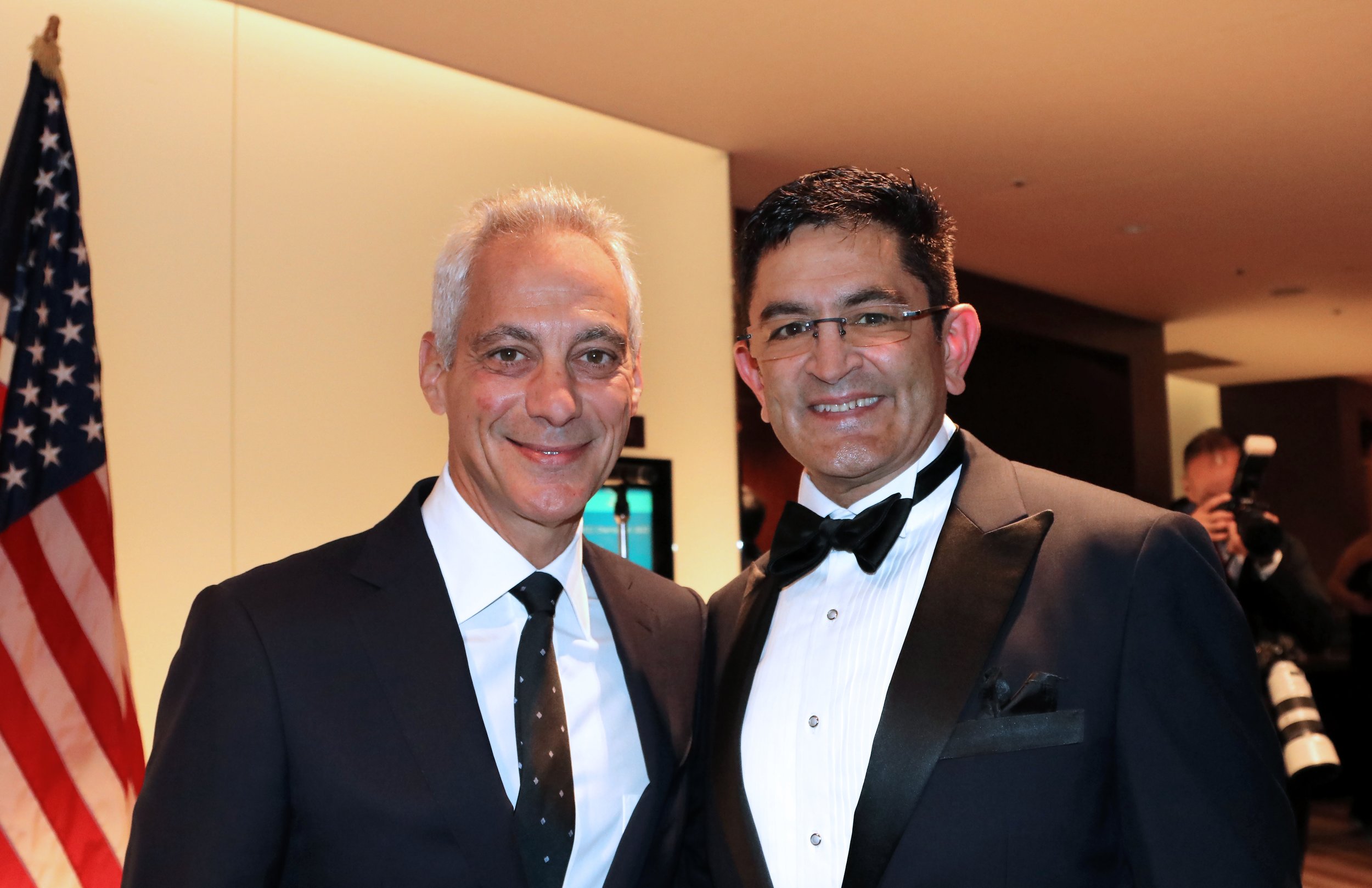
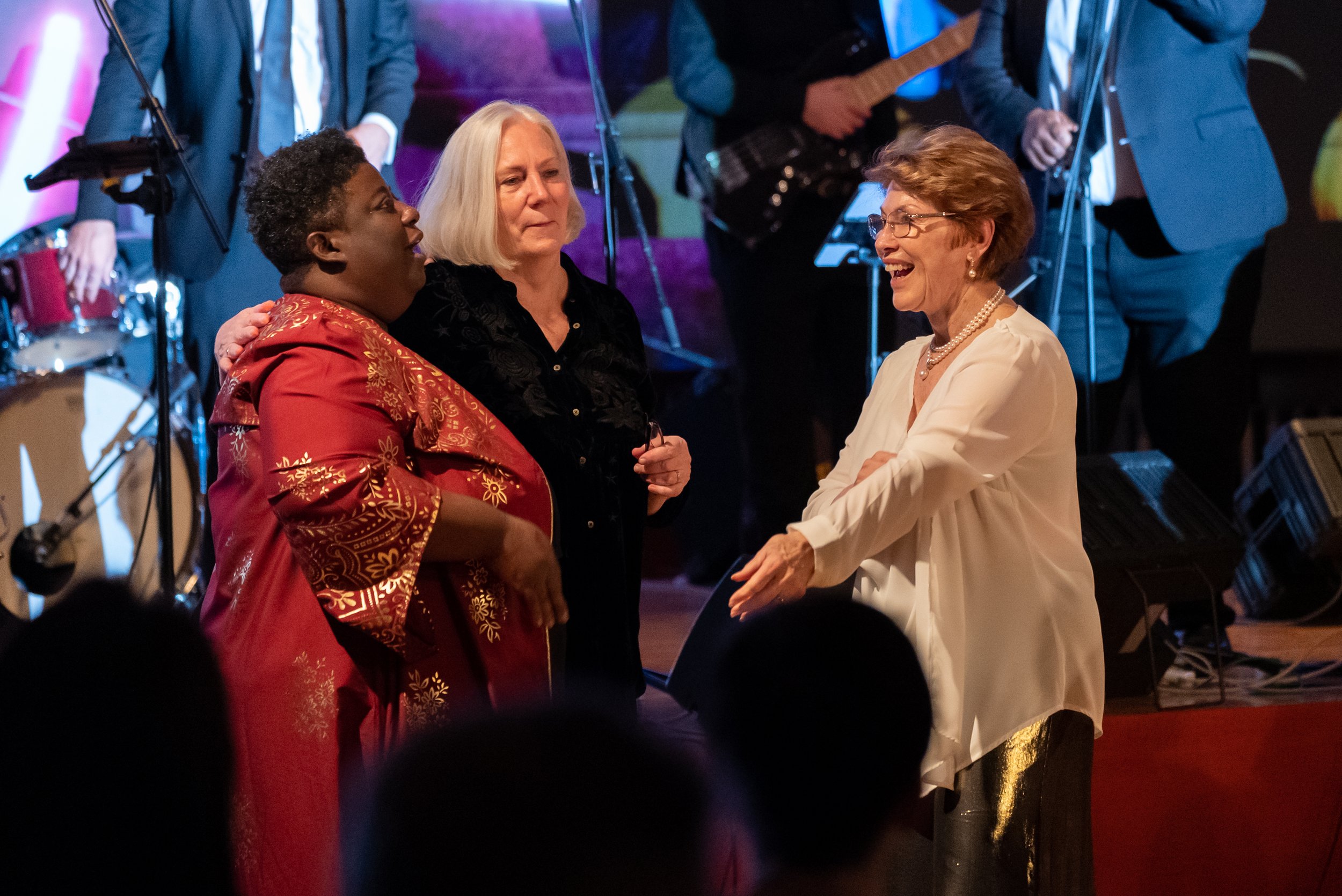

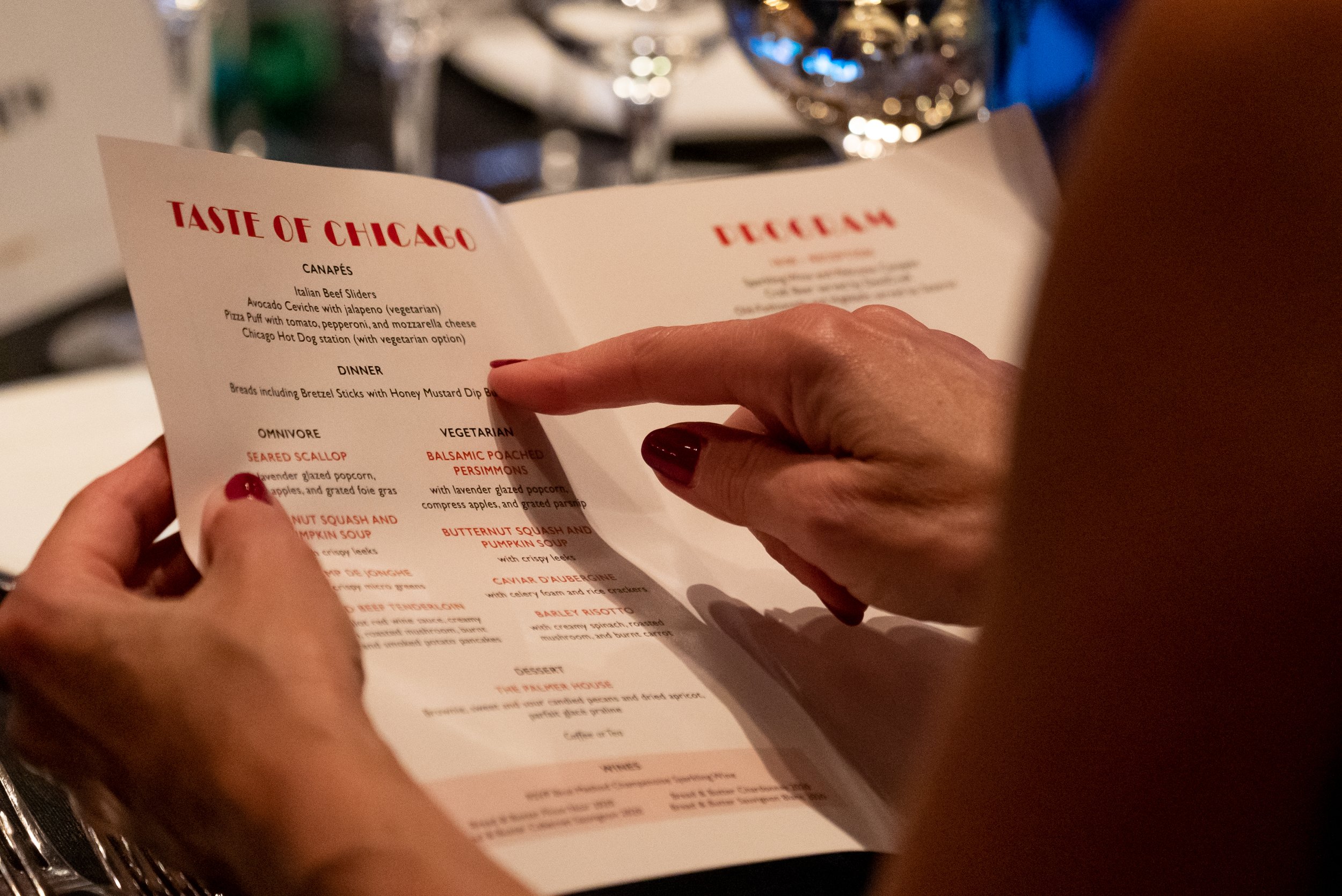
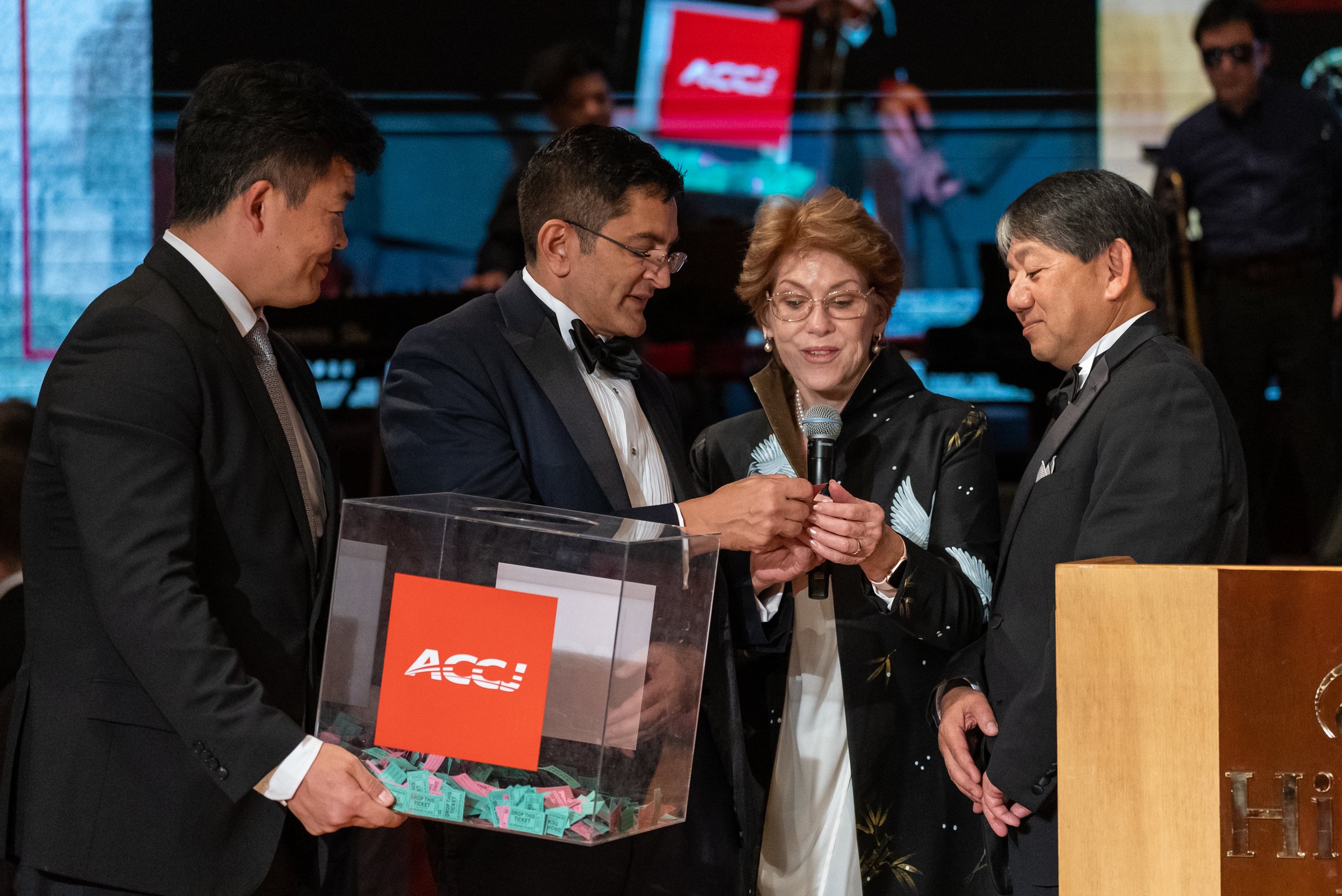
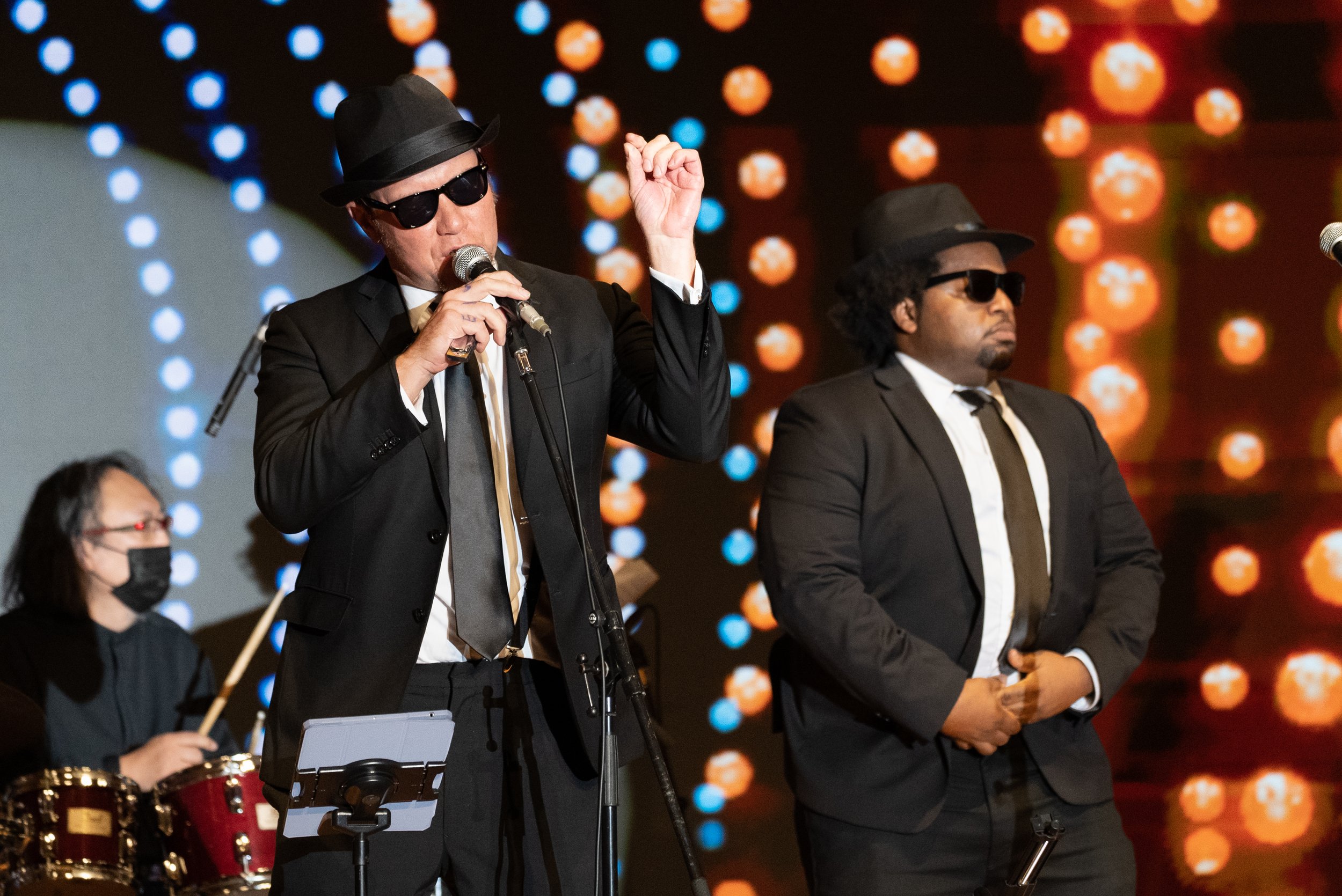
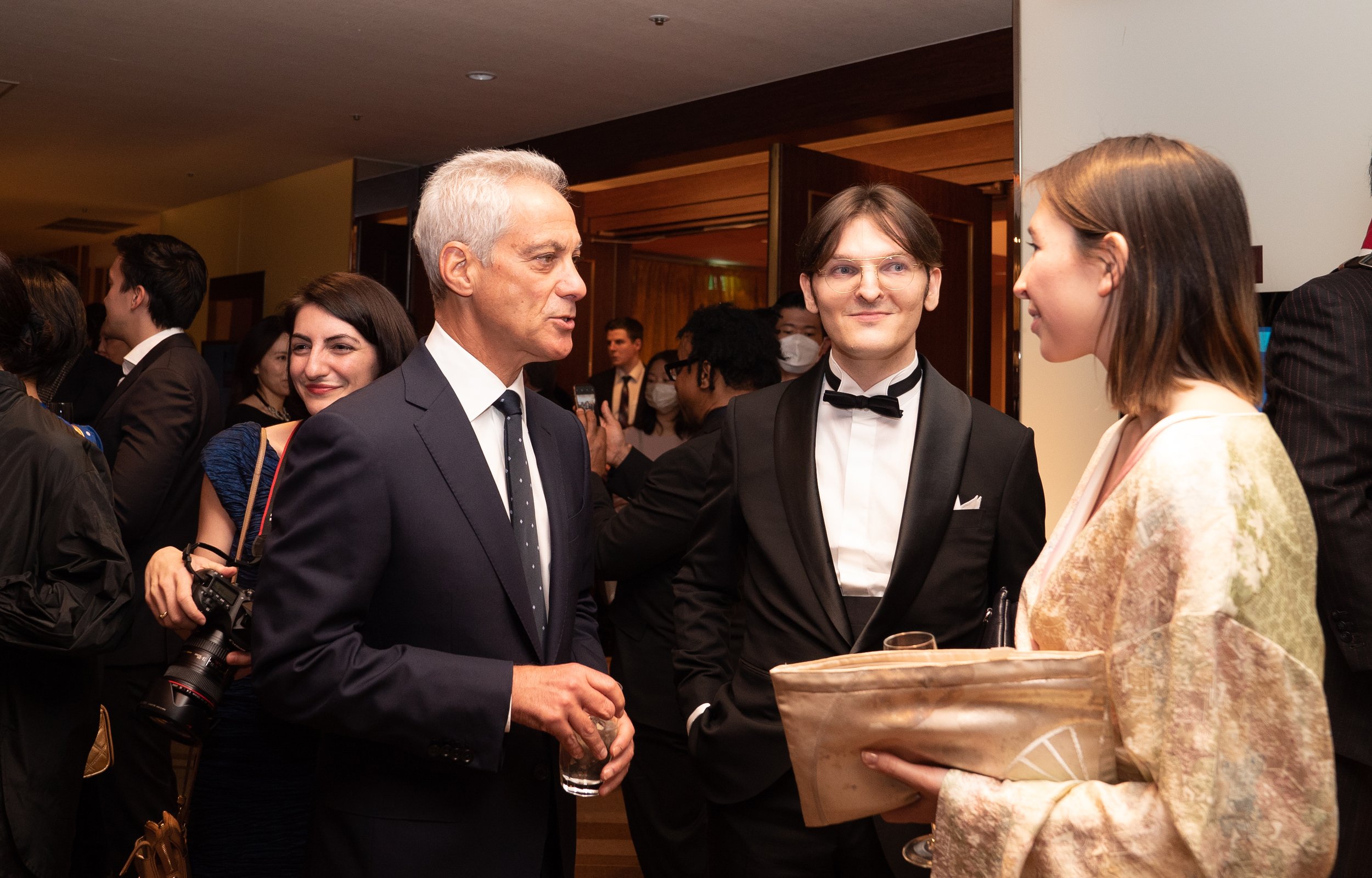

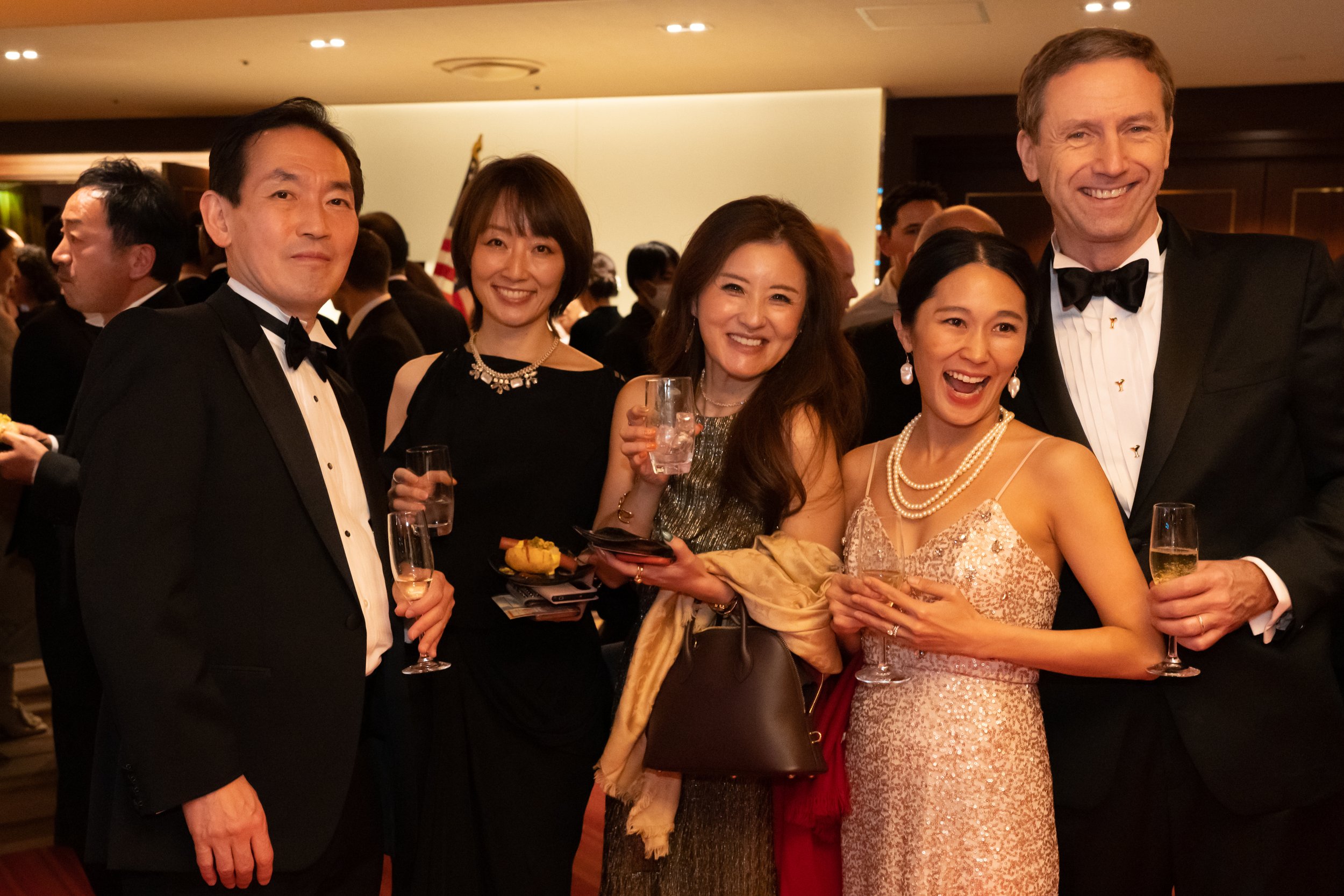

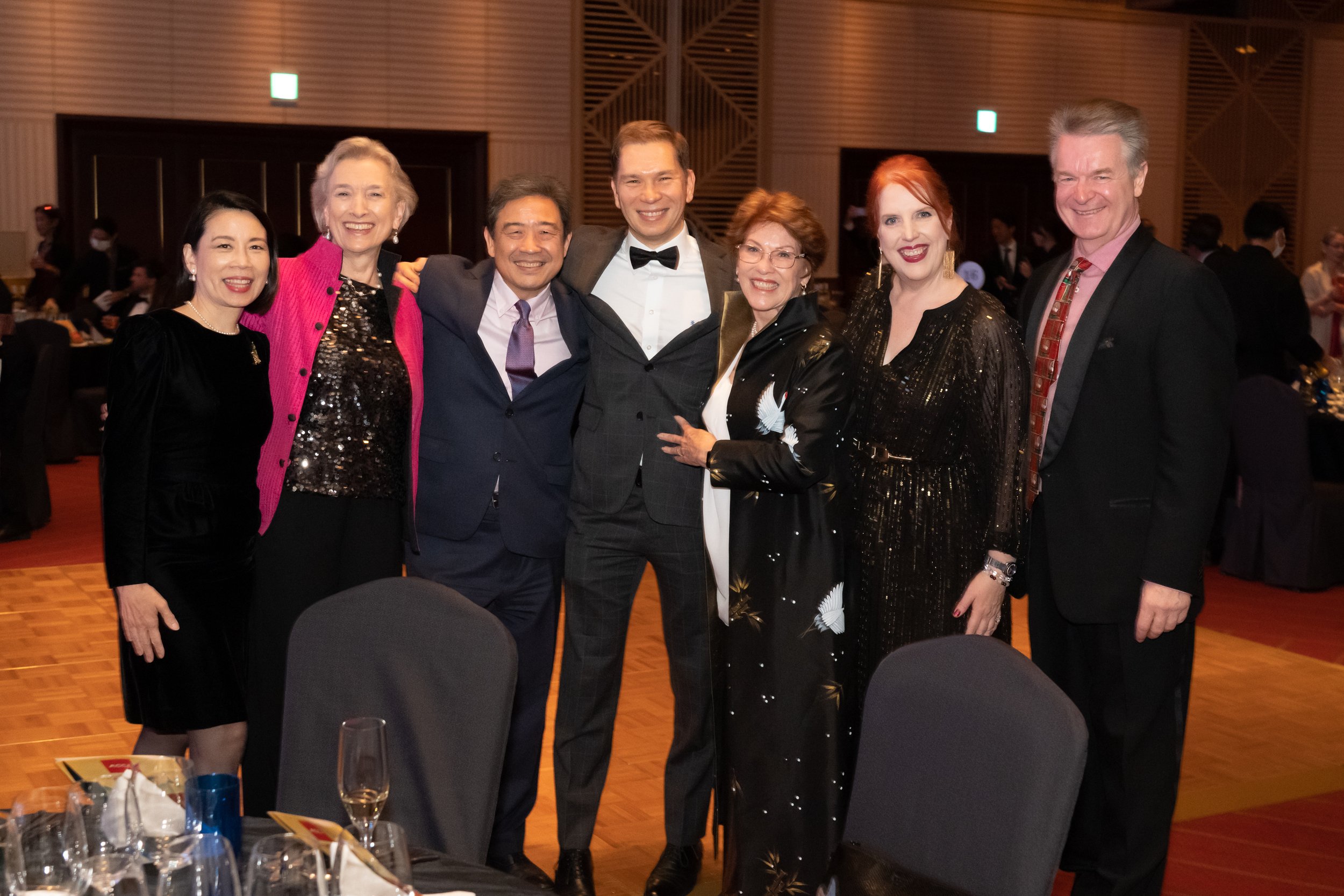
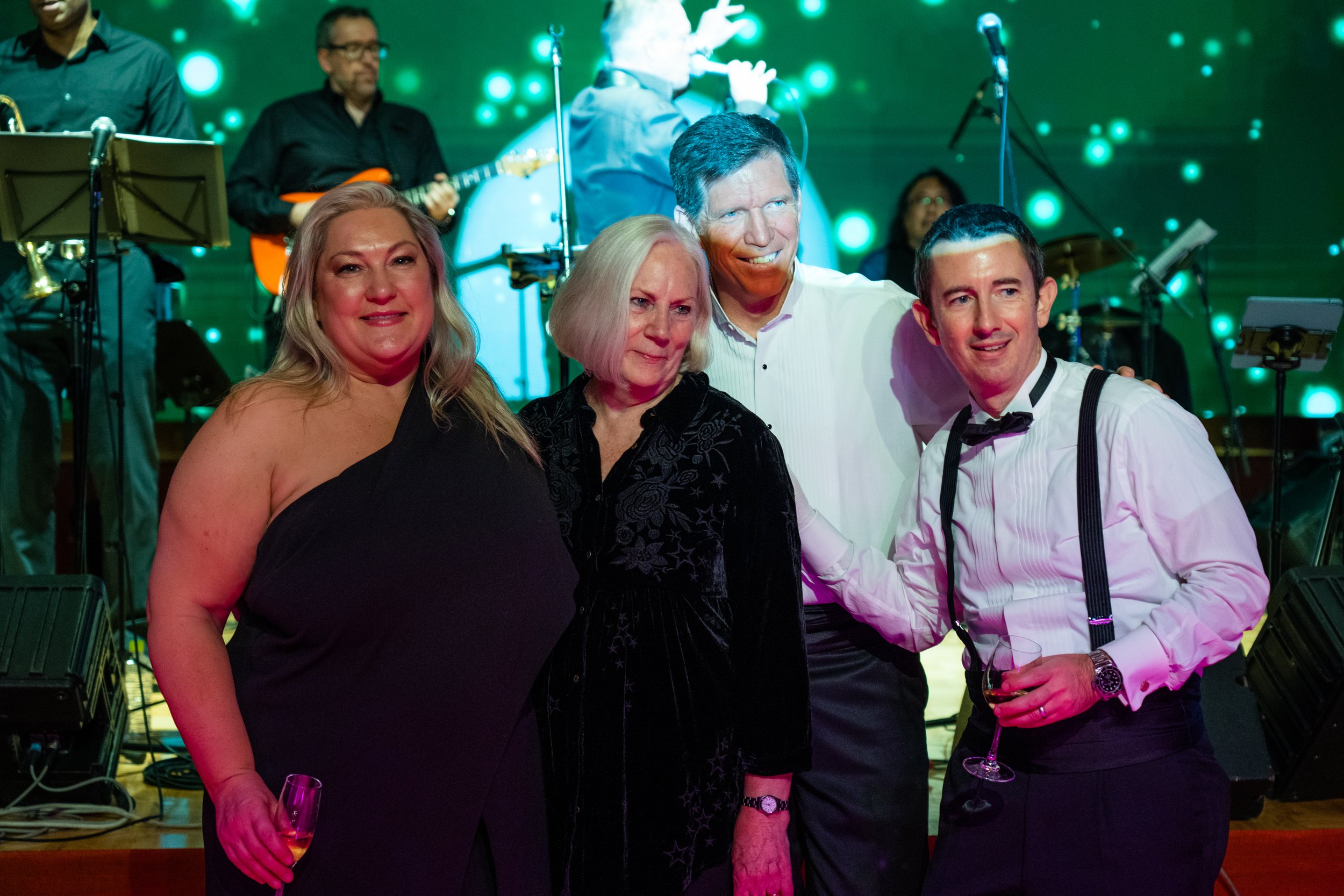
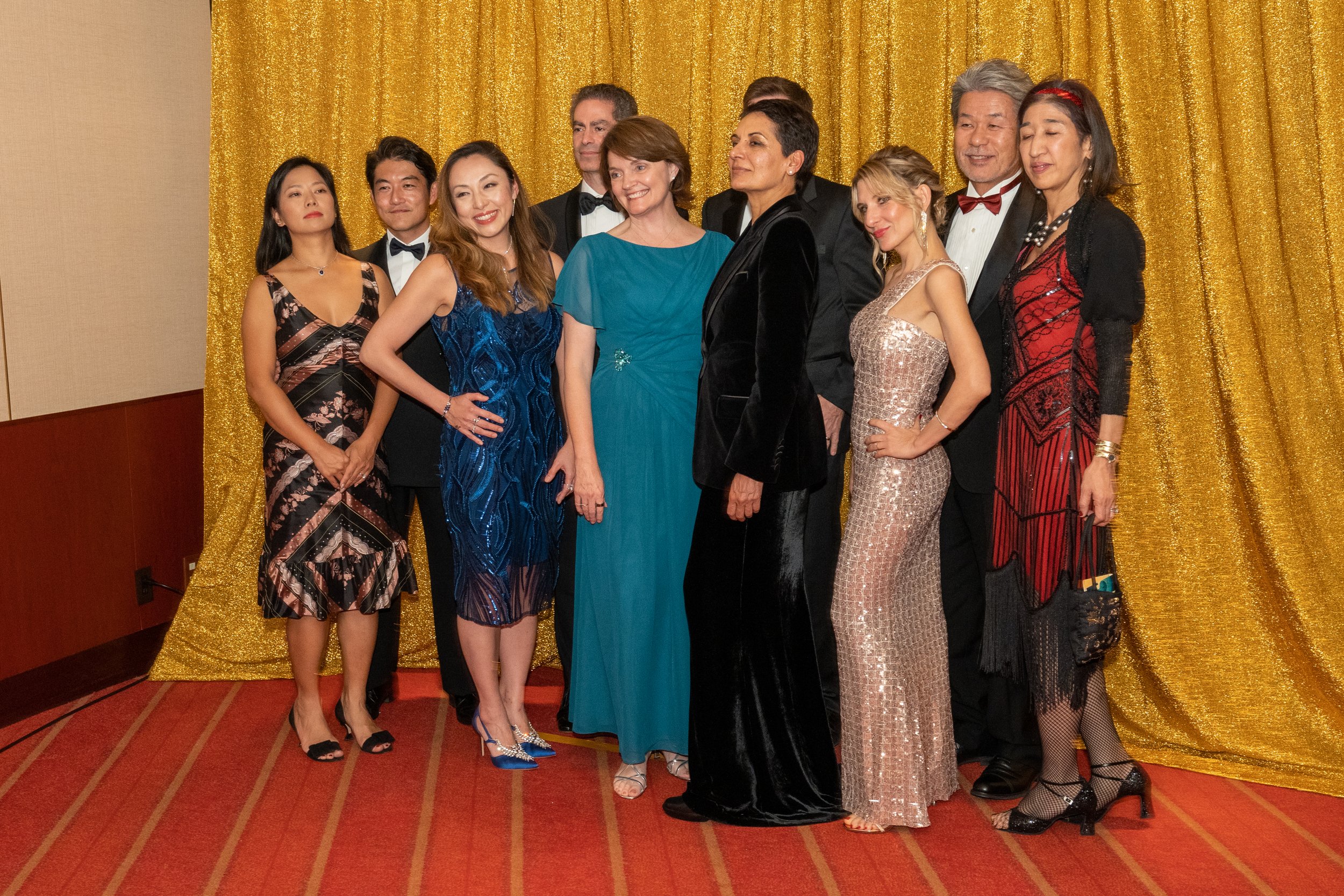
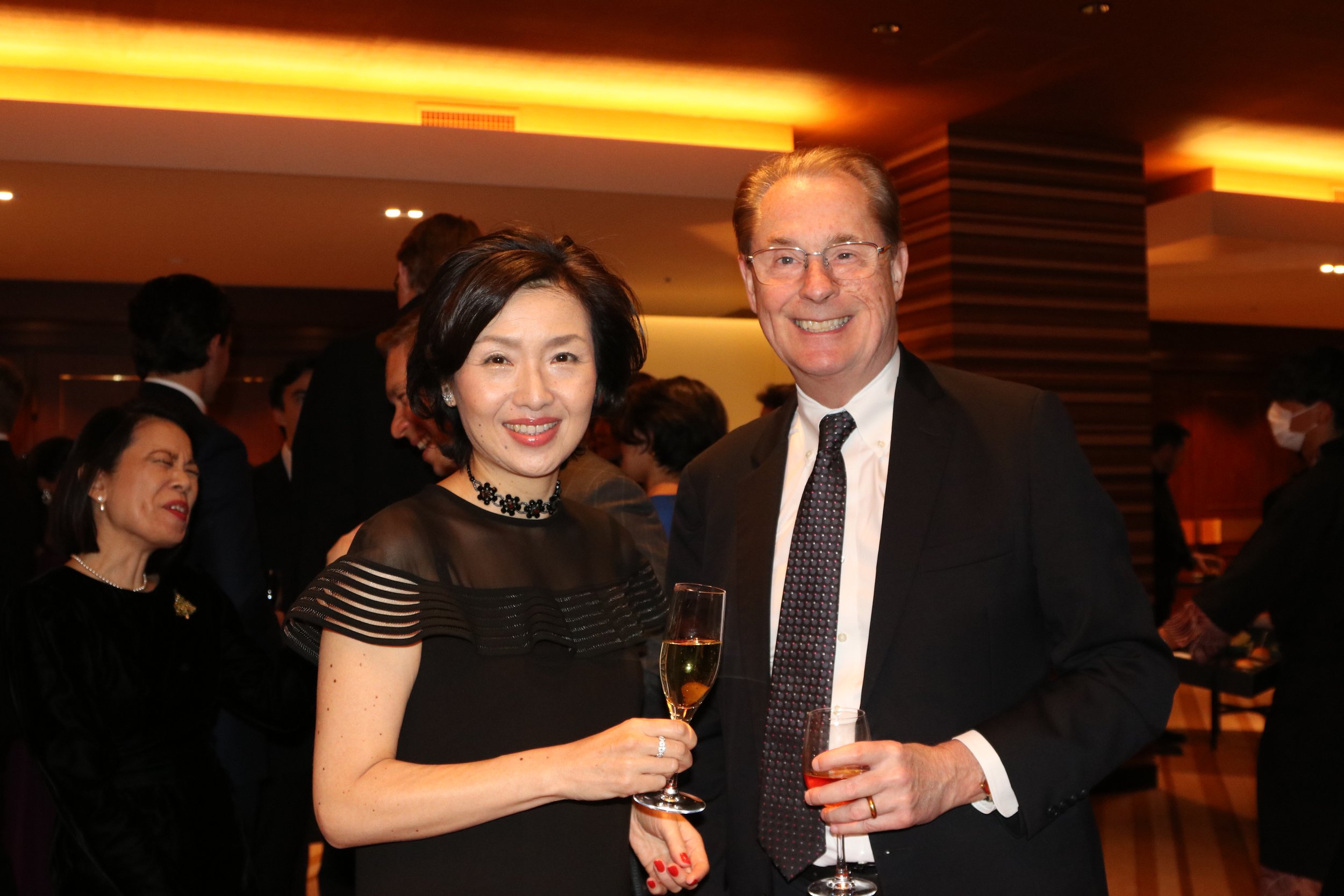


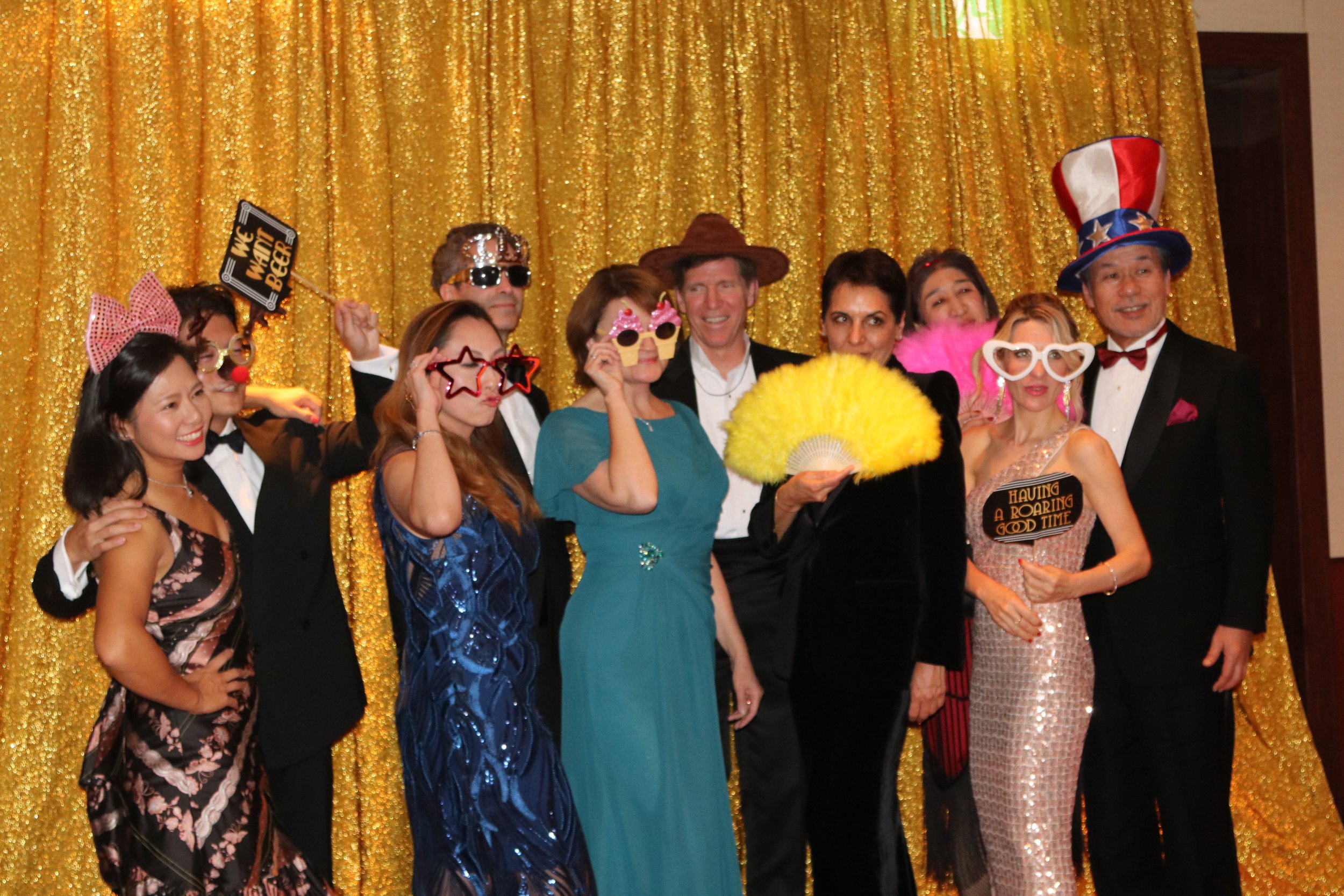
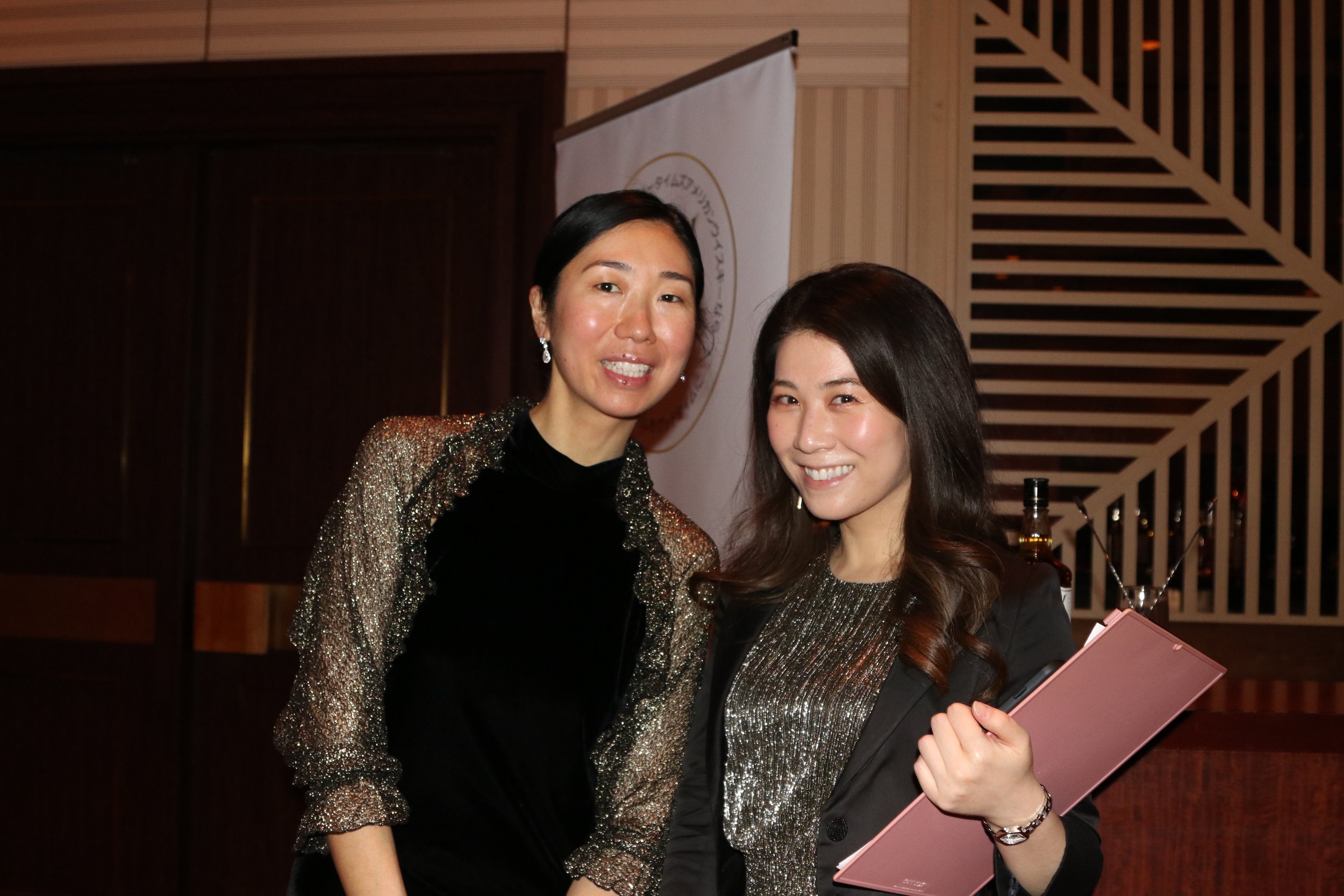


Photo of Ambassador Emanuel: US Embassy, Tokyo • All other photos: Media Sense K.K.
President’s Circle Sponsors
Platinum Sponsor
Thomson Reuters
Bronze Sponsors
AIG Companies in Japan
Coca-Cola (Japan) Co., Ltd.
Prudential Financial, Inc.
Gold Sponsor
Boeing Japan K.K.
Mercury Sponsors
Morgan, Lewis, & Bockius LLP
American Automobiles Space
NRK Sogo Kikaku Co. Ltd.
Prize Sponsors
Diamond
Air Canada
Aquasense Hotel & Resort
Delta Air Lines
Double Bounce Productions Inc.
Fufu Hakone
Herman Miller Japan, Ltd.
KOA Production Inc.
Marriott International, Inc.
MediaSense K.K.
MnK Niseko
United Airlines, Inc.
Vega Project K.K.
Ruby
Andaz Tokyo Toranomon Hills
Grand Hyatt Tokyo
Hakuba Hotel Group
Sapphire
Amway Japan G.K.
Dhillon Marty Inc.
ELC Japan K.K. (Estée Lauder)
Mondelēz Japan Ltd.
Park Hyatt Tokyo
Shop Japan
Sunrockers, Ltd.
Tokyo American Club
Emerald
All Nippon Airways Co., Ltd.
ANA InterContinental Tokyo
Antenna America
Asian Tigers Mobility
Big Picture International, K.K.
Bistro Vino Cellars
Conrad Tokyo
DevilCraft
Eastern Carpets
Elana Jade
Enplus Inc.
Food-e
Godiva Japan Inc.
Hafele Japan K.K.
HARIBO Japan
Hilton Tokyo
Hilton Tokyo BayHotel Indigo Inuyama Urakuen Garden
Hotel Indigo Karuizawa
Hyatt Regencv Kyoto
Jupiter International Corporation
M. ISHII & SONS
Northrop Grumman Japan
Palmer House
pearls.jp
Riedel Japan
Sazerac Japan
Simon Dalby Art
The Strings by InterContinental Tokyo
Temple University Japan Campus
Tsingtao Brewery
Yellow Toes Art Gallery
YouMeWe




